Technology Acceptance Model in E-Commerce Segment
VerifiedAdded on 2022/11/26
|15
|7185
|50
AI Summary
This research paper focuses on the technology acceptance model in the context of e-commerce segment. It analyzes the impact of user experience factors on e-commerce websites and explores the use of modern technologies such as social networks and mobile apps. The study aims to create a model that explains the impact of each major factor on the user experience and the re-visit of the e-shop.
Contribute Materials
Your contribution can guide someone’s learning journey. Share your
documents today.

Technology acceptance model in e-commerce segment
Igor FEDORKO
University of Prešov, Prešov, Slovak Republic
igor.fedorko@unipo.sk
Radovan BACIK
University of Prešov, Prešov, Slovak Republic
radovan.bacik@unipo.sk
Beata GAVUROVA
Research and Innovation Centre Bioinformatics, TECHNICOM, Kosice, Slovakia
Faculty of Economics, Technical University of Košice, Košice, Slovak Republic
beata.gavurova@tuke.sk
Abstract. Consumer behaviour analysis is a key aspect for the success of e-business. The main objective
of the study is to analyse the impact of selected user experience factors on e-commerce web site visiting
(technology). The objective of the study is to create a model that will explain the impact of each major
factor on the user experience and the re-visit of the e-shop. To explain the use of e-commerce
technology, in the second part we have modified the original technology acceptance model (TAM) with
other constructs. Specifically, there are modern technologies such as social networks or mobile apps
that affect the use of e-shops. The TAM model is one of the most used models of what the system uses to
identify the perceived usefulness and perceived simplicity of use from the user' side. For the main
advantage of our study, we consider that we have highlighted the importance of the factor of modern
technology and therefore of social networks, mobile applications and contextual advertising. This
factor, along with the other two factors, has been incorporated into our model and has shown that
modern technologies have a direct impact and are therefore directly related to the frequency using the
e-commerce websites.
Keywords: TAM, consumer behavior, e-commerce, user experience.
Please cite the article as follows: Fedorko, I., Bacik, R. & Gavurova, B. (2018), “Technology
Acceptance Model in E-Commerce Segment”, Management & Marketing. Challenges for the
Knowledge Society, Vol. 13, No. 4, pp. 1242-1256, DOI: 10.2478/mmcks-2018-0034.
Introduction
By 2020, four billion people are expected to be online, suggesting that addressing
customers’ needs will be more important than ever (IDC, 2015). Marketers needs to
continually improve business strategies and models (Ungerman et al., 2018). With the
advancement of digital platforms, online shopping environments are evolving as well, and
they are able to offer consumers more options in the purchase process, providing them with
better services and products (Pappas, 2018). It is important to identify the reasons that
customers choose to visit an online store and following their shopping motivations. It ist
important to understand how their behavior differs based on their predisposition towards
modern online shopping. Many theories and models have been proposed over the years to
explain the individuals' usage behavior towards technologies (Momani et al., 2017). This
research paper focuses on the technology acceptance model in context of e-commerce
Igor FEDORKO
University of Prešov, Prešov, Slovak Republic
igor.fedorko@unipo.sk
Radovan BACIK
University of Prešov, Prešov, Slovak Republic
radovan.bacik@unipo.sk
Beata GAVUROVA
Research and Innovation Centre Bioinformatics, TECHNICOM, Kosice, Slovakia
Faculty of Economics, Technical University of Košice, Košice, Slovak Republic
beata.gavurova@tuke.sk
Abstract. Consumer behaviour analysis is a key aspect for the success of e-business. The main objective
of the study is to analyse the impact of selected user experience factors on e-commerce web site visiting
(technology). The objective of the study is to create a model that will explain the impact of each major
factor on the user experience and the re-visit of the e-shop. To explain the use of e-commerce
technology, in the second part we have modified the original technology acceptance model (TAM) with
other constructs. Specifically, there are modern technologies such as social networks or mobile apps
that affect the use of e-shops. The TAM model is one of the most used models of what the system uses to
identify the perceived usefulness and perceived simplicity of use from the user' side. For the main
advantage of our study, we consider that we have highlighted the importance of the factor of modern
technology and therefore of social networks, mobile applications and contextual advertising. This
factor, along with the other two factors, has been incorporated into our model and has shown that
modern technologies have a direct impact and are therefore directly related to the frequency using the
e-commerce websites.
Keywords: TAM, consumer behavior, e-commerce, user experience.
Please cite the article as follows: Fedorko, I., Bacik, R. & Gavurova, B. (2018), “Technology
Acceptance Model in E-Commerce Segment”, Management & Marketing. Challenges for the
Knowledge Society, Vol. 13, No. 4, pp. 1242-1256, DOI: 10.2478/mmcks-2018-0034.
Introduction
By 2020, four billion people are expected to be online, suggesting that addressing
customers’ needs will be more important than ever (IDC, 2015). Marketers needs to
continually improve business strategies and models (Ungerman et al., 2018). With the
advancement of digital platforms, online shopping environments are evolving as well, and
they are able to offer consumers more options in the purchase process, providing them with
better services and products (Pappas, 2018). It is important to identify the reasons that
customers choose to visit an online store and following their shopping motivations. It ist
important to understand how their behavior differs based on their predisposition towards
modern online shopping. Many theories and models have been proposed over the years to
explain the individuals' usage behavior towards technologies (Momani et al., 2017). This
research paper focuses on the technology acceptance model in context of e-commerce
Secure Best Marks with AI Grader
Need help grading? Try our AI Grader for instant feedback on your assignments.
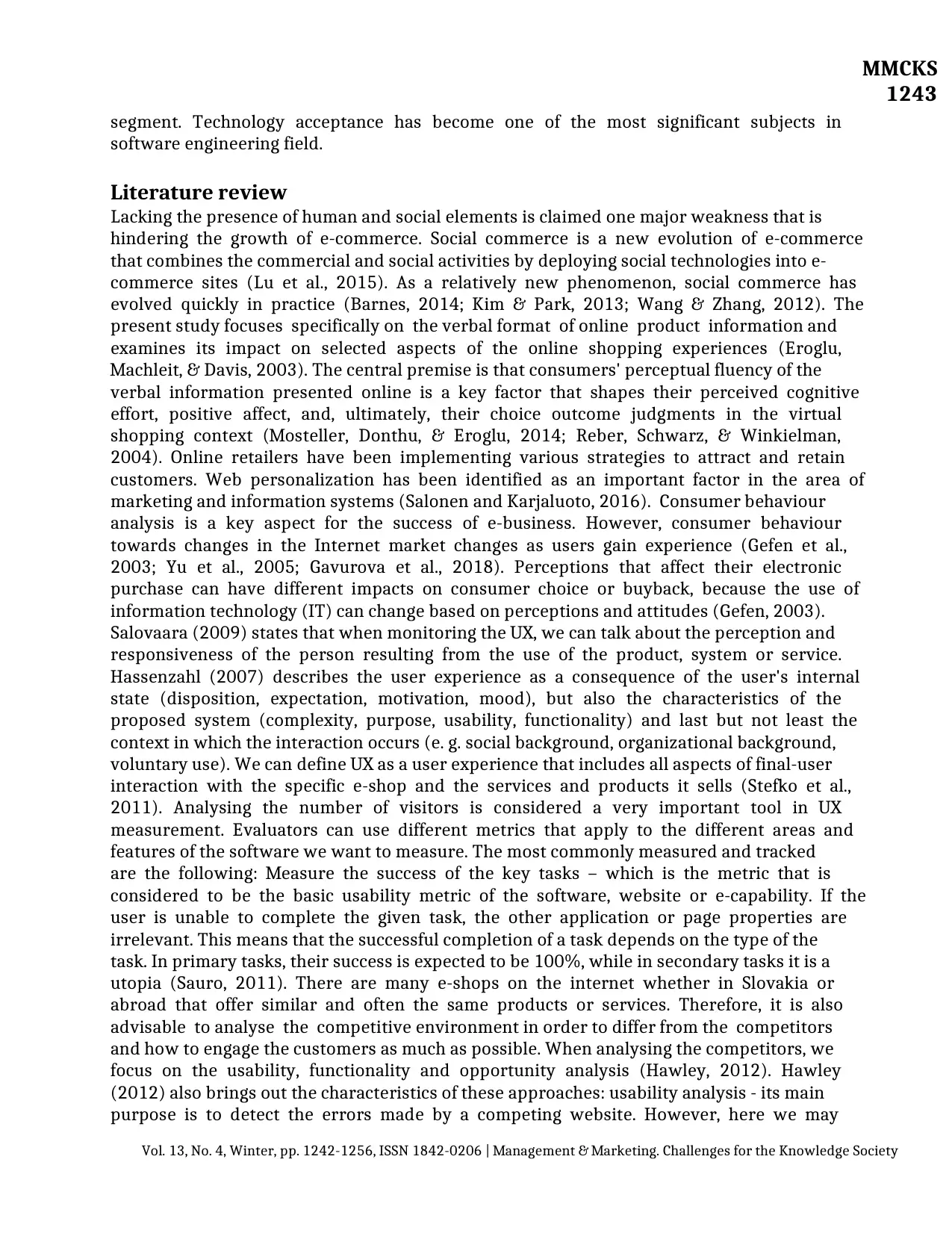
MMCKS
1243
Vol. 13, No. 4, Winter, pp. 1242-1256, ISSN 1842-0206 | Management & Marketing. Challenges for the Knowledge Society
segment. Technology acceptance has become one of the most significant subjects in
software engineering field.
Literature review
Lacking the presence of human and social elements is claimed one major weakness that is
hindering the growth of e-commerce. Social commerce is a new evolution of e-commerce
that combines the commercial and social activities by deploying social technologies into e-
commerce sites (Lu et al., 2015). As a relatively new phenomenon, social commerce has
evolved quickly in practice (Barnes, 2014; Kim & Park, 2013; Wang & Zhang, 2012). The
present study focuses specifically on the verbal format of online product information and
examines its impact on selected aspects of the online shopping experiences (Eroglu,
Machleit, & Davis, 2003). The central premise is that consumers' perceptual fluency of the
verbal information presented online is a key factor that shapes their perceived cognitive
effort, positive affect, and, ultimately, their choice outcome judgments in the virtual
shopping context (Mosteller, Donthu, & Eroglu, 2014; Reber, Schwarz, & Winkielman,
2004). Online retailers have been implementing various strategies to attract and retain
customers. Web personalization has been identified as an important factor in the area of
marketing and information systems (Salonen and Karjaluoto, 2016). Consumer behaviour
analysis is a key aspect for the success of e-business. However, consumer behaviour
towards changes in the Internet market changes as users gain experience (Gefen et al.,
2003; Yu et al., 2005; Gavurova et al., 2018). Perceptions that affect their electronic
purchase can have different impacts on consumer choice or buyback, because the use of
information technology (IT) can change based on perceptions and attitudes (Gefen, 2003).
Salovaara (2009) states that when monitoring the UX, we can talk about the perception and
responsiveness of the person resulting from the use of the product, system or service.
Hassenzahl (2007) describes the user experience as a consequence of the user's internal
state (disposition, expectation, motivation, mood), but also the characteristics of the
proposed system (complexity, purpose, usability, functionality) and last but not least the
context in which the interaction occurs (e. g. social background, organizational background,
voluntary use). We can define UX as a user experience that includes all aspects of final-user
interaction with the specific e-shop and the services and products it sells (Stefko et al.,
2011). Analysing the number of visitors is considered a very important tool in UX
measurement. Evaluators can use different metrics that apply to the different areas and
features of the software we want to measure. The most commonly measured and tracked
are the following: Measure the success of the key tasks – which is the metric that is
considered to be the basic usability metric of the software, website or e-capability. If the
user is unable to complete the given task, the other application or page properties are
irrelevant. This means that the successful completion of a task depends on the type of the
task. In primary tasks, their success is expected to be 100%, while in secondary tasks it is a
utopia (Sauro, 2011). There are many e-shops on the internet whether in Slovakia or
abroad that offer similar and often the same products or services. Therefore, it is also
advisable to analyse the competitive environment in order to differ from the competitors
and how to engage the customers as much as possible. When analysing the competitors, we
focus on the usability, functionality and opportunity analysis (Hawley, 2012). Hawley
(2012) also brings out the characteristics of these approaches: usability analysis - its main
purpose is to detect the errors made by a competing website. However, here we may
1243
Vol. 13, No. 4, Winter, pp. 1242-1256, ISSN 1842-0206 | Management & Marketing. Challenges for the Knowledge Society
segment. Technology acceptance has become one of the most significant subjects in
software engineering field.
Literature review
Lacking the presence of human and social elements is claimed one major weakness that is
hindering the growth of e-commerce. Social commerce is a new evolution of e-commerce
that combines the commercial and social activities by deploying social technologies into e-
commerce sites (Lu et al., 2015). As a relatively new phenomenon, social commerce has
evolved quickly in practice (Barnes, 2014; Kim & Park, 2013; Wang & Zhang, 2012). The
present study focuses specifically on the verbal format of online product information and
examines its impact on selected aspects of the online shopping experiences (Eroglu,
Machleit, & Davis, 2003). The central premise is that consumers' perceptual fluency of the
verbal information presented online is a key factor that shapes their perceived cognitive
effort, positive affect, and, ultimately, their choice outcome judgments in the virtual
shopping context (Mosteller, Donthu, & Eroglu, 2014; Reber, Schwarz, & Winkielman,
2004). Online retailers have been implementing various strategies to attract and retain
customers. Web personalization has been identified as an important factor in the area of
marketing and information systems (Salonen and Karjaluoto, 2016). Consumer behaviour
analysis is a key aspect for the success of e-business. However, consumer behaviour
towards changes in the Internet market changes as users gain experience (Gefen et al.,
2003; Yu et al., 2005; Gavurova et al., 2018). Perceptions that affect their electronic
purchase can have different impacts on consumer choice or buyback, because the use of
information technology (IT) can change based on perceptions and attitudes (Gefen, 2003).
Salovaara (2009) states that when monitoring the UX, we can talk about the perception and
responsiveness of the person resulting from the use of the product, system or service.
Hassenzahl (2007) describes the user experience as a consequence of the user's internal
state (disposition, expectation, motivation, mood), but also the characteristics of the
proposed system (complexity, purpose, usability, functionality) and last but not least the
context in which the interaction occurs (e. g. social background, organizational background,
voluntary use). We can define UX as a user experience that includes all aspects of final-user
interaction with the specific e-shop and the services and products it sells (Stefko et al.,
2011). Analysing the number of visitors is considered a very important tool in UX
measurement. Evaluators can use different metrics that apply to the different areas and
features of the software we want to measure. The most commonly measured and tracked
are the following: Measure the success of the key tasks – which is the metric that is
considered to be the basic usability metric of the software, website or e-capability. If the
user is unable to complete the given task, the other application or page properties are
irrelevant. This means that the successful completion of a task depends on the type of the
task. In primary tasks, their success is expected to be 100%, while in secondary tasks it is a
utopia (Sauro, 2011). There are many e-shops on the internet whether in Slovakia or
abroad that offer similar and often the same products or services. Therefore, it is also
advisable to analyse the competitive environment in order to differ from the competitors
and how to engage the customers as much as possible. When analysing the competitors, we
focus on the usability, functionality and opportunity analysis (Hawley, 2012). Hawley
(2012) also brings out the characteristics of these approaches: usability analysis - its main
purpose is to detect the errors made by a competing website. However, here we may
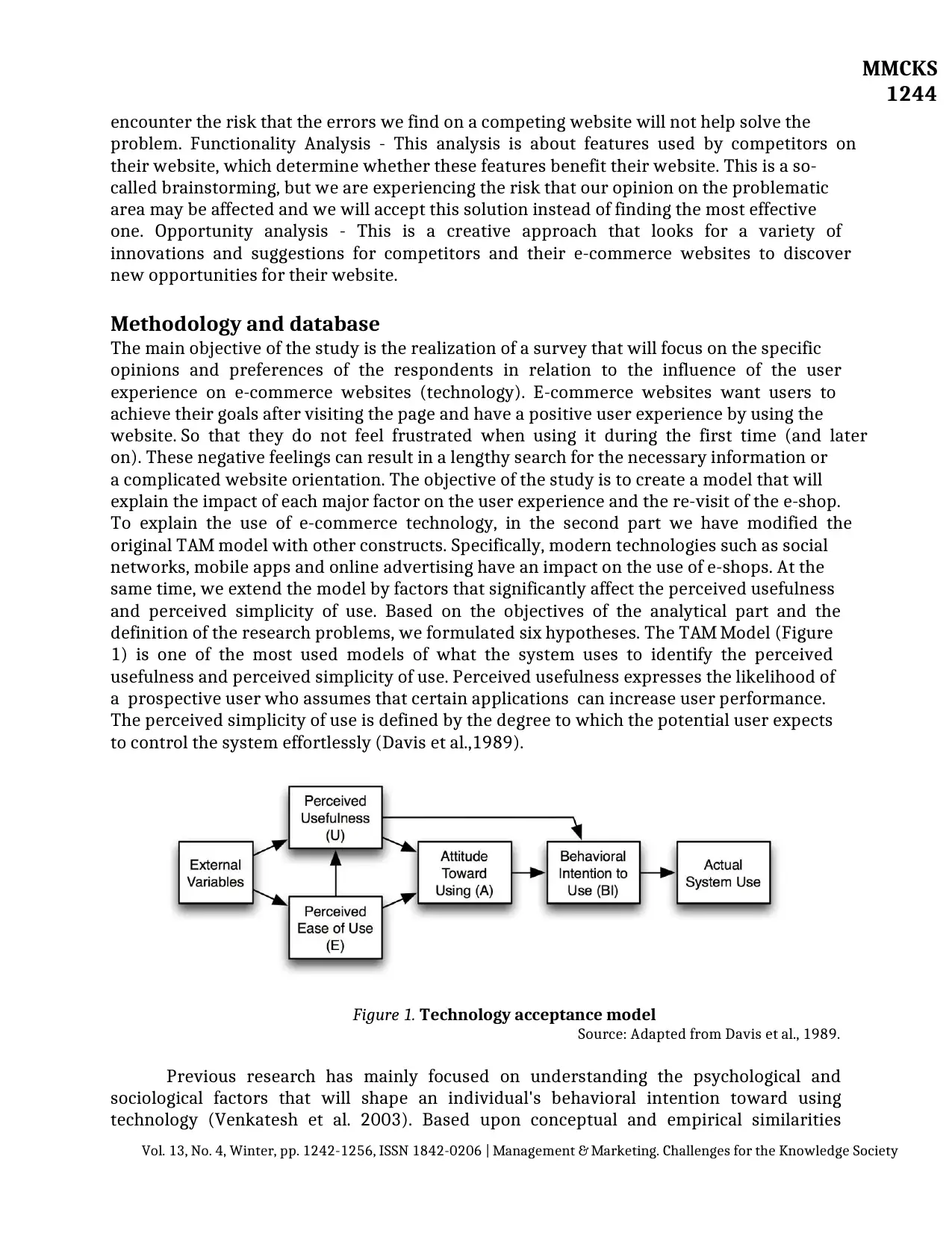
MMCKS
1244
Vol. 13, No. 4, Winter, pp. 1242-1256, ISSN 1842-0206 | Management & Marketing. Challenges for the Knowledge Society
encounter the risk that the errors we find on a competing website will not help solve the
problem. Functionality Analysis - This analysis is about features used by competitors on
their website, which determine whether these features benefit their website. This is a so-
called brainstorming, but we are experiencing the risk that our opinion on the problematic
area may be affected and we will accept this solution instead of finding the most effective
one. Opportunity analysis - This is a creative approach that looks for a variety of
innovations and suggestions for competitors and their e-commerce websites to discover
new opportunities for their website.
Methodology and database
The main objective of the study is the realization of a survey that will focus on the specific
opinions and preferences of the respondents in relation to the influence of the user
experience on e-commerce websites (technology). E-commerce websites want users to
achieve their goals after visiting the page and have a positive user experience by using the
website. So that they do not feel frustrated when using it during the first time (and later
on). These negative feelings can result in a lengthy search for the necessary information or
a complicated website orientation. The objective of the study is to create a model that will
explain the impact of each major factor on the user experience and the re-visit of the e-shop.
To explain the use of e-commerce technology, in the second part we have modified the
original TAM model with other constructs. Specifically, modern technologies such as social
networks, mobile apps and online advertising have an impact on the use of e-shops. At the
same time, we extend the model by factors that significantly affect the perceived usefulness
and perceived simplicity of use. Based on the objectives of the analytical part and the
definition of the research problems, we formulated six hypotheses. The TAM Model (Figure
1) is one of the most used models of what the system uses to identify the perceived
usefulness and perceived simplicity of use. Perceived usefulness expresses the likelihood of
a prospective user who assumes that certain applications can increase user performance.
The perceived simplicity of use is defined by the degree to which the potential user expects
to control the system effortlessly (Davis et al.,1989).
Figure 1. Technology acceptance model
Source: Adapted from Davis et al., 1989.
Previous research has mainly focused on understanding the psychological and
sociological factors that will shape an individual's behavioral intention toward using
technology (Venkatesh et al. 2003). Based upon conceptual and empirical similarities
1244
Vol. 13, No. 4, Winter, pp. 1242-1256, ISSN 1842-0206 | Management & Marketing. Challenges for the Knowledge Society
encounter the risk that the errors we find on a competing website will not help solve the
problem. Functionality Analysis - This analysis is about features used by competitors on
their website, which determine whether these features benefit their website. This is a so-
called brainstorming, but we are experiencing the risk that our opinion on the problematic
area may be affected and we will accept this solution instead of finding the most effective
one. Opportunity analysis - This is a creative approach that looks for a variety of
innovations and suggestions for competitors and their e-commerce websites to discover
new opportunities for their website.
Methodology and database
The main objective of the study is the realization of a survey that will focus on the specific
opinions and preferences of the respondents in relation to the influence of the user
experience on e-commerce websites (technology). E-commerce websites want users to
achieve their goals after visiting the page and have a positive user experience by using the
website. So that they do not feel frustrated when using it during the first time (and later
on). These negative feelings can result in a lengthy search for the necessary information or
a complicated website orientation. The objective of the study is to create a model that will
explain the impact of each major factor on the user experience and the re-visit of the e-shop.
To explain the use of e-commerce technology, in the second part we have modified the
original TAM model with other constructs. Specifically, modern technologies such as social
networks, mobile apps and online advertising have an impact on the use of e-shops. At the
same time, we extend the model by factors that significantly affect the perceived usefulness
and perceived simplicity of use. Based on the objectives of the analytical part and the
definition of the research problems, we formulated six hypotheses. The TAM Model (Figure
1) is one of the most used models of what the system uses to identify the perceived
usefulness and perceived simplicity of use. Perceived usefulness expresses the likelihood of
a prospective user who assumes that certain applications can increase user performance.
The perceived simplicity of use is defined by the degree to which the potential user expects
to control the system effortlessly (Davis et al.,1989).
Figure 1. Technology acceptance model
Source: Adapted from Davis et al., 1989.
Previous research has mainly focused on understanding the psychological and
sociological factors that will shape an individual's behavioral intention toward using
technology (Venkatesh et al. 2003). Based upon conceptual and empirical similarities
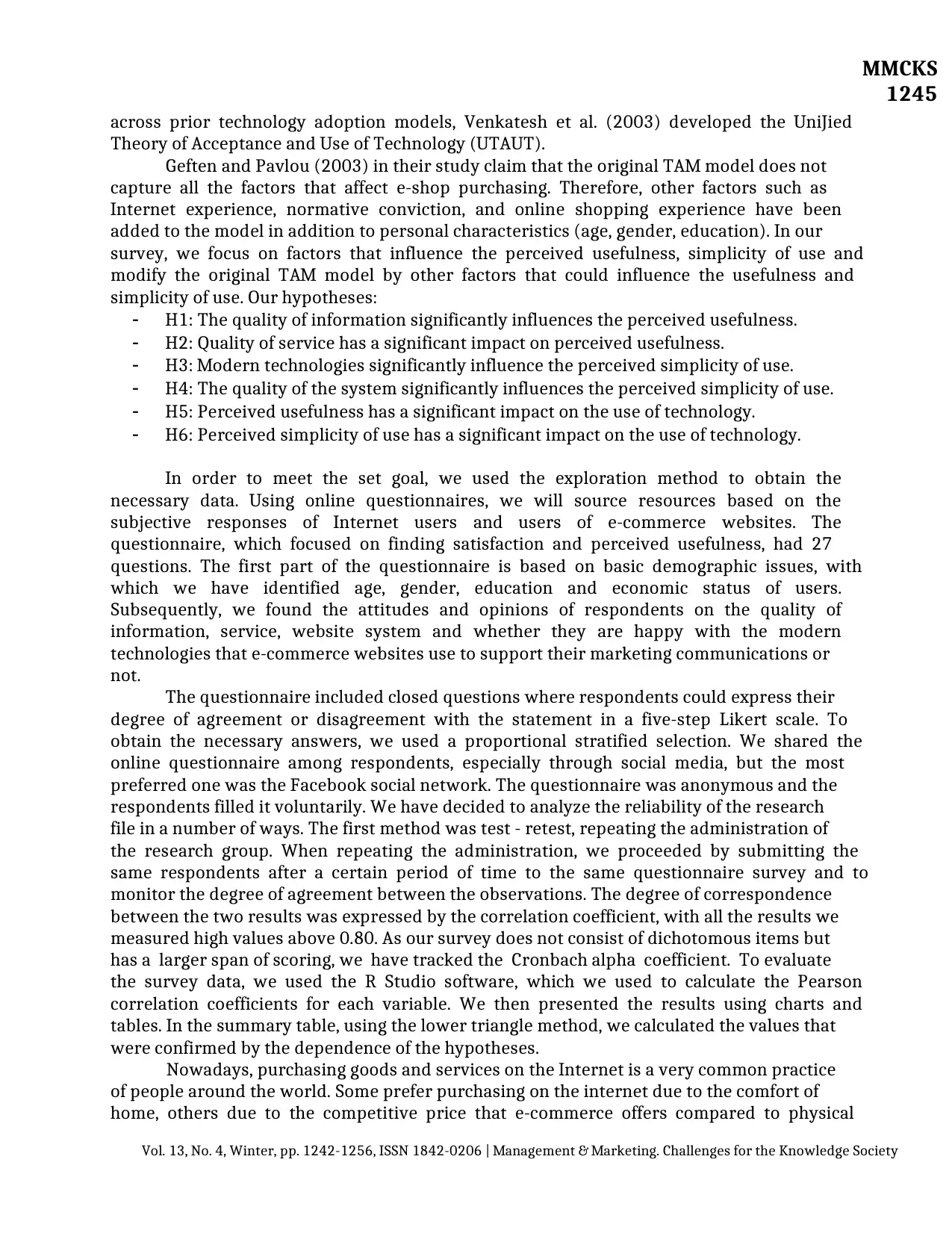
MMCKS
1245
Vol. 13, No. 4, Winter, pp. 1242-1256, ISSN 1842-0206 | Management & Marketing. Challenges for the Knowledge Society
across prior technology adoption models, Venkatesh et al. (2003) developed the UniJied
Theory of Acceptance and Use of Technology (UTAUT).
Geften and Pavlou (2003) in their study claim that the original TAM model does not
capture all the factors that affect e-shop purchasing. Therefore, other factors such as
Internet experience, normative conviction, and online shopping experience have been
added to the model in addition to personal characteristics (age, gender, education). In our
survey, we focus on factors that influence the perceived usefulness, simplicity of use and
modify the original TAM model by other factors that could influence the usefulness and
simplicity of use. Our hypotheses:
H1: The quality of information significantly influences the perceived usefulness.
H2: Quality of service has a significant impact on perceived usefulness.
H3: Modern technologies significantly influence the perceived simplicity of use.
H4: The quality of the system significantly influences the perceived simplicity of use.
H5: Perceived usefulness has a significant impact on the use of technology.
H6: Perceived simplicity of use has a significant impact on the use of technology.
In order to meet the set goal, we used the exploration method to obtain the
necessary data. Using online questionnaires, we will source resources based on the
subjective responses of Internet users and users of e-commerce websites. The
questionnaire, which focused on finding satisfaction and perceived usefulness, had 27
questions. The first part of the questionnaire is based on basic demographic issues, with
which we have identified age, gender, education and economic status of users.
Subsequently, we found the attitudes and opinions of respondents on the quality of
information, service, website system and whether they are happy with the modern
technologies that e-commerce websites use to support their marketing communications or
not.
The questionnaire included closed questions where respondents could express their
degree of agreement or disagreement with the statement in a five-step Likert scale. To
obtain the necessary answers, we used a proportional stratified selection. We shared the
online questionnaire among respondents, especially through social media, but the most
preferred one was the Facebook social network. The questionnaire was anonymous and the
respondents filled it voluntarily. We have decided to analyze the reliability of the research
file in a number of ways. The first method was test - retest, repeating the administration of
the research group. When repeating the administration, we proceeded by submitting the
same respondents after a certain period of time to the same questionnaire survey and to
monitor the degree of agreement between the observations. The degree of correspondence
between the two results was expressed by the correlation coefficient, with all the results we
measured high values above 0.80. As our survey does not consist of dichotomous items but
has a larger span of scoring, we have tracked the Cronbach alpha coefficient. To evaluate
the survey data, we used the R Studio software, which we used to calculate the Pearson
correlation coefficients for each variable. We then presented the results using charts and
tables. In the summary table, using the lower triangle method, we calculated the values that
were confirmed by the dependence of the hypotheses.
Nowadays, purchasing goods and services on the Internet is a very common practice
of people around the world. Some prefer purchasing on the internet due to the comfort of
home, others due to the competitive price that e-commerce offers compared to physical
1245
Vol. 13, No. 4, Winter, pp. 1242-1256, ISSN 1842-0206 | Management & Marketing. Challenges for the Knowledge Society
across prior technology adoption models, Venkatesh et al. (2003) developed the UniJied
Theory of Acceptance and Use of Technology (UTAUT).
Geften and Pavlou (2003) in their study claim that the original TAM model does not
capture all the factors that affect e-shop purchasing. Therefore, other factors such as
Internet experience, normative conviction, and online shopping experience have been
added to the model in addition to personal characteristics (age, gender, education). In our
survey, we focus on factors that influence the perceived usefulness, simplicity of use and
modify the original TAM model by other factors that could influence the usefulness and
simplicity of use. Our hypotheses:
H1: The quality of information significantly influences the perceived usefulness.
H2: Quality of service has a significant impact on perceived usefulness.
H3: Modern technologies significantly influence the perceived simplicity of use.
H4: The quality of the system significantly influences the perceived simplicity of use.
H5: Perceived usefulness has a significant impact on the use of technology.
H6: Perceived simplicity of use has a significant impact on the use of technology.
In order to meet the set goal, we used the exploration method to obtain the
necessary data. Using online questionnaires, we will source resources based on the
subjective responses of Internet users and users of e-commerce websites. The
questionnaire, which focused on finding satisfaction and perceived usefulness, had 27
questions. The first part of the questionnaire is based on basic demographic issues, with
which we have identified age, gender, education and economic status of users.
Subsequently, we found the attitudes and opinions of respondents on the quality of
information, service, website system and whether they are happy with the modern
technologies that e-commerce websites use to support their marketing communications or
not.
The questionnaire included closed questions where respondents could express their
degree of agreement or disagreement with the statement in a five-step Likert scale. To
obtain the necessary answers, we used a proportional stratified selection. We shared the
online questionnaire among respondents, especially through social media, but the most
preferred one was the Facebook social network. The questionnaire was anonymous and the
respondents filled it voluntarily. We have decided to analyze the reliability of the research
file in a number of ways. The first method was test - retest, repeating the administration of
the research group. When repeating the administration, we proceeded by submitting the
same respondents after a certain period of time to the same questionnaire survey and to
monitor the degree of agreement between the observations. The degree of correspondence
between the two results was expressed by the correlation coefficient, with all the results we
measured high values above 0.80. As our survey does not consist of dichotomous items but
has a larger span of scoring, we have tracked the Cronbach alpha coefficient. To evaluate
the survey data, we used the R Studio software, which we used to calculate the Pearson
correlation coefficients for each variable. We then presented the results using charts and
tables. In the summary table, using the lower triangle method, we calculated the values that
were confirmed by the dependence of the hypotheses.
Nowadays, purchasing goods and services on the Internet is a very common practice
of people around the world. Some prefer purchasing on the internet due to the comfort of
home, others due to the competitive price that e-commerce offers compared to physical
Secure Best Marks with AI Grader
Need help grading? Try our AI Grader for instant feedback on your assignments.
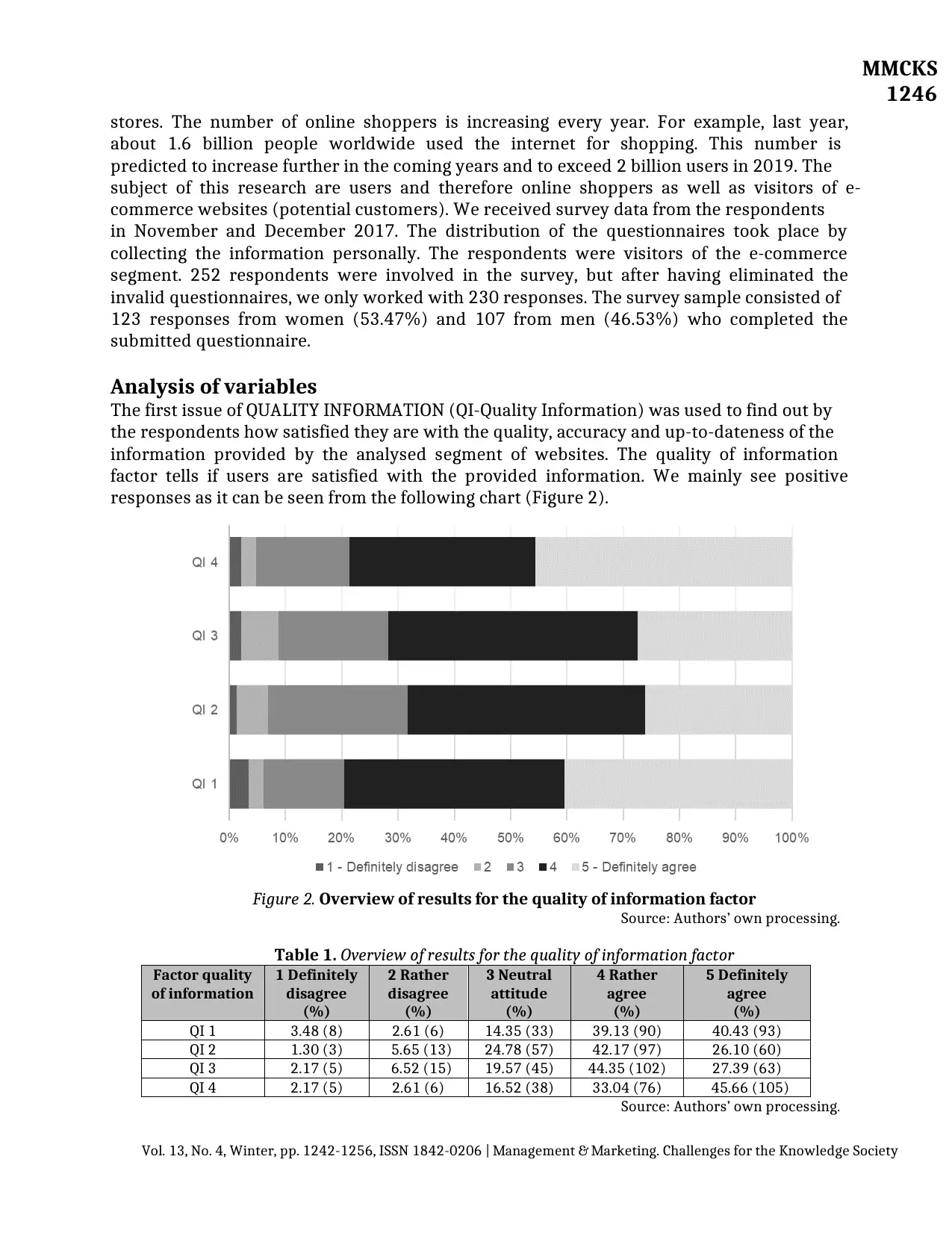
MMCKS
1246
Vol. 13, No. 4, Winter, pp. 1242-1256, ISSN 1842-0206 | Management & Marketing. Challenges for the Knowledge Society
stores. The number of online shoppers is increasing every year. For example, last year,
about 1.6 billion people worldwide used the internet for shopping. This number is
predicted to increase further in the coming years and to exceed 2 billion users in 2019. The
subject of this research are users and therefore online shoppers as well as visitors of e-
commerce websites (potential customers). We received survey data from the respondents
in November and December 2017. The distribution of the questionnaires took place by
collecting the information personally. The respondents were visitors of the e-commerce
segment. 252 respondents were involved in the survey, but after having eliminated the
invalid questionnaires, we only worked with 230 responses. The survey sample consisted of
123 responses from women (53.47%) and 107 from men (46.53%) who completed the
submitted questionnaire.
Analysis of variables
The first issue of QUALITY INFORMATION (QI-Quality Information) was used to find out by
the respondents how satisfied they are with the quality, accuracy and up-to-dateness of the
information provided by the analysed segment of websites. The quality of information
factor tells if users are satisfied with the provided information. We mainly see positive
responses as it can be seen from the following chart (Figure 2).
Figure 2. Overview of results for the quality of information factor
Source: Authors’ own processing.
Table 1. Overview of results for the quality of information factor
Factor quality
of information
1 Definitely
disagree
(%)
2 Rather
disagree
(%)
3 Neutral
attitude
(%)
4 Rather
agree
(%)
5 Definitely
agree
(%)
QI 1 3.48 (8) 2.61 (6) 14.35 (33) 39.13 (90) 40.43 (93)
QI 2 1.30 (3) 5.65 (13) 24.78 (57) 42.17 (97) 26.10 (60)
QI 3 2.17 (5) 6.52 (15) 19.57 (45) 44.35 (102) 27.39 (63)
QI 4 2.17 (5) 2.61 (6) 16.52 (38) 33.04 (76) 45.66 (105)
Source: Authors’ own processing.
1246
Vol. 13, No. 4, Winter, pp. 1242-1256, ISSN 1842-0206 | Management & Marketing. Challenges for the Knowledge Society
stores. The number of online shoppers is increasing every year. For example, last year,
about 1.6 billion people worldwide used the internet for shopping. This number is
predicted to increase further in the coming years and to exceed 2 billion users in 2019. The
subject of this research are users and therefore online shoppers as well as visitors of e-
commerce websites (potential customers). We received survey data from the respondents
in November and December 2017. The distribution of the questionnaires took place by
collecting the information personally. The respondents were visitors of the e-commerce
segment. 252 respondents were involved in the survey, but after having eliminated the
invalid questionnaires, we only worked with 230 responses. The survey sample consisted of
123 responses from women (53.47%) and 107 from men (46.53%) who completed the
submitted questionnaire.
Analysis of variables
The first issue of QUALITY INFORMATION (QI-Quality Information) was used to find out by
the respondents how satisfied they are with the quality, accuracy and up-to-dateness of the
information provided by the analysed segment of websites. The quality of information
factor tells if users are satisfied with the provided information. We mainly see positive
responses as it can be seen from the following chart (Figure 2).
Figure 2. Overview of results for the quality of information factor
Source: Authors’ own processing.
Table 1. Overview of results for the quality of information factor
Factor quality
of information
1 Definitely
disagree
(%)
2 Rather
disagree
(%)
3 Neutral
attitude
(%)
4 Rather
agree
(%)
5 Definitely
agree
(%)
QI 1 3.48 (8) 2.61 (6) 14.35 (33) 39.13 (90) 40.43 (93)
QI 2 1.30 (3) 5.65 (13) 24.78 (57) 42.17 (97) 26.10 (60)
QI 3 2.17 (5) 6.52 (15) 19.57 (45) 44.35 (102) 27.39 (63)
QI 4 2.17 (5) 2.61 (6) 16.52 (38) 33.04 (76) 45.66 (105)
Source: Authors’ own processing.
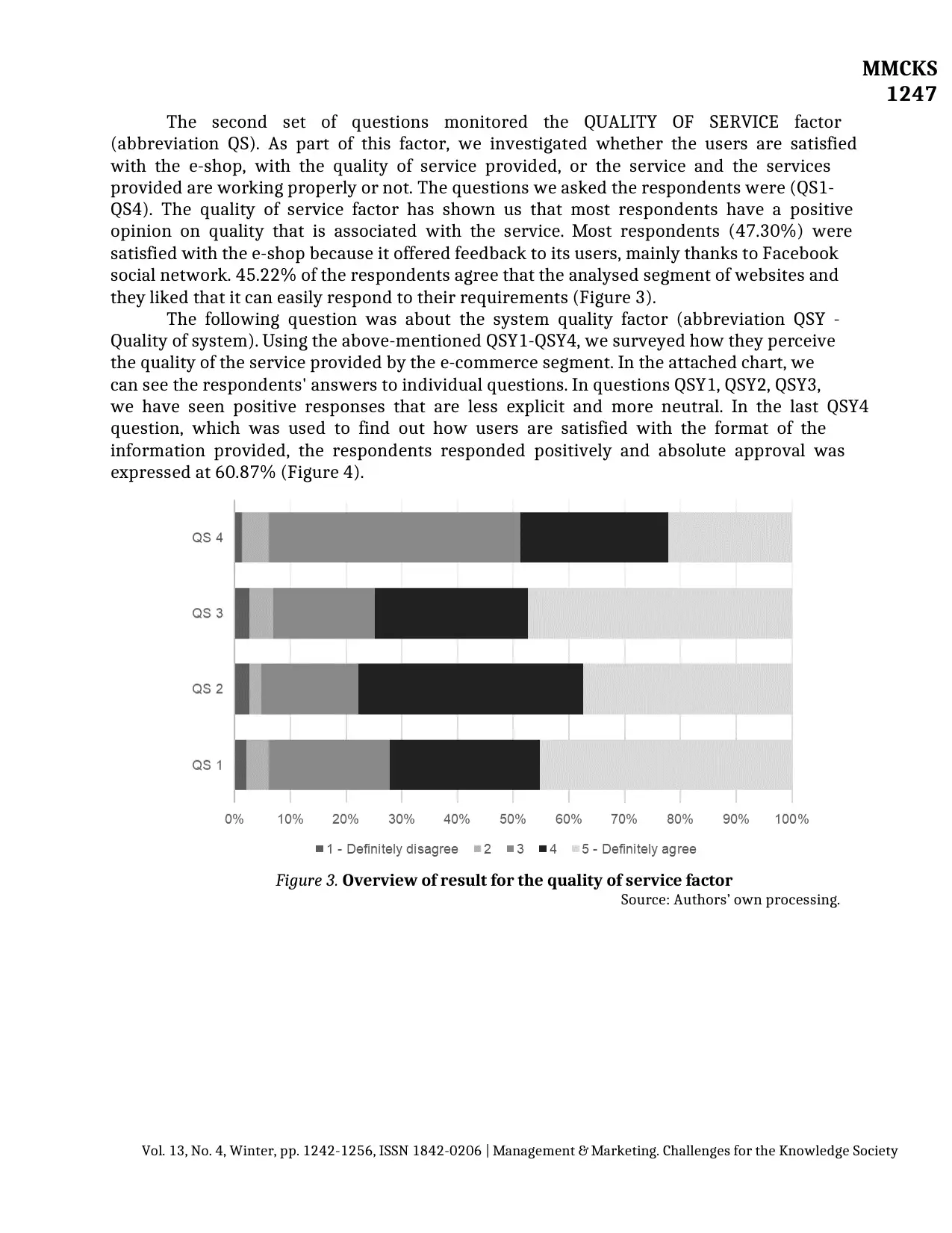
MMCKS
1247
Vol. 13, No. 4, Winter, pp. 1242-1256, ISSN 1842-0206 | Management & Marketing. Challenges for the Knowledge Society
The second set of questions monitored the QUALITY OF SERVICE factor
(abbreviation QS). As part of this factor, we investigated whether the users are satisfied
with the e-shop, with the quality of service provided, or the service and the services
provided are working properly or not. The questions we asked the respondents were (QS1-
QS4). The quality of service factor has shown us that most respondents have a positive
opinion on quality that is associated with the service. Most respondents (47.30%) were
satisfied with the e-shop because it offered feedback to its users, mainly thanks to Facebook
social network. 45.22% of the respondents agree that the analysed segment of websites and
they liked that it can easily respond to their requirements (Figure 3).
The following question was about the system quality factor (abbreviation QSY -
Quality of system). Using the above-mentioned QSY1-QSY4, we surveyed how they perceive
the quality of the service provided by the e-commerce segment. In the attached chart, we
can see the respondents' answers to individual questions. In questions QSY1, QSY2, QSY3,
we have seen positive responses that are less explicit and more neutral. In the last QSY4
question, which was used to find out how users are satisfied with the format of the
information provided, the respondents responded positively and absolute approval was
expressed at 60.87% (Figure 4).
Figure 3. Overview of result for the quality of service factor
Source: Authors’ own processing.
1247
Vol. 13, No. 4, Winter, pp. 1242-1256, ISSN 1842-0206 | Management & Marketing. Challenges for the Knowledge Society
The second set of questions monitored the QUALITY OF SERVICE factor
(abbreviation QS). As part of this factor, we investigated whether the users are satisfied
with the e-shop, with the quality of service provided, or the service and the services
provided are working properly or not. The questions we asked the respondents were (QS1-
QS4). The quality of service factor has shown us that most respondents have a positive
opinion on quality that is associated with the service. Most respondents (47.30%) were
satisfied with the e-shop because it offered feedback to its users, mainly thanks to Facebook
social network. 45.22% of the respondents agree that the analysed segment of websites and
they liked that it can easily respond to their requirements (Figure 3).
The following question was about the system quality factor (abbreviation QSY -
Quality of system). Using the above-mentioned QSY1-QSY4, we surveyed how they perceive
the quality of the service provided by the e-commerce segment. In the attached chart, we
can see the respondents' answers to individual questions. In questions QSY1, QSY2, QSY3,
we have seen positive responses that are less explicit and more neutral. In the last QSY4
question, which was used to find out how users are satisfied with the format of the
information provided, the respondents responded positively and absolute approval was
expressed at 60.87% (Figure 4).
Figure 3. Overview of result for the quality of service factor
Source: Authors’ own processing.
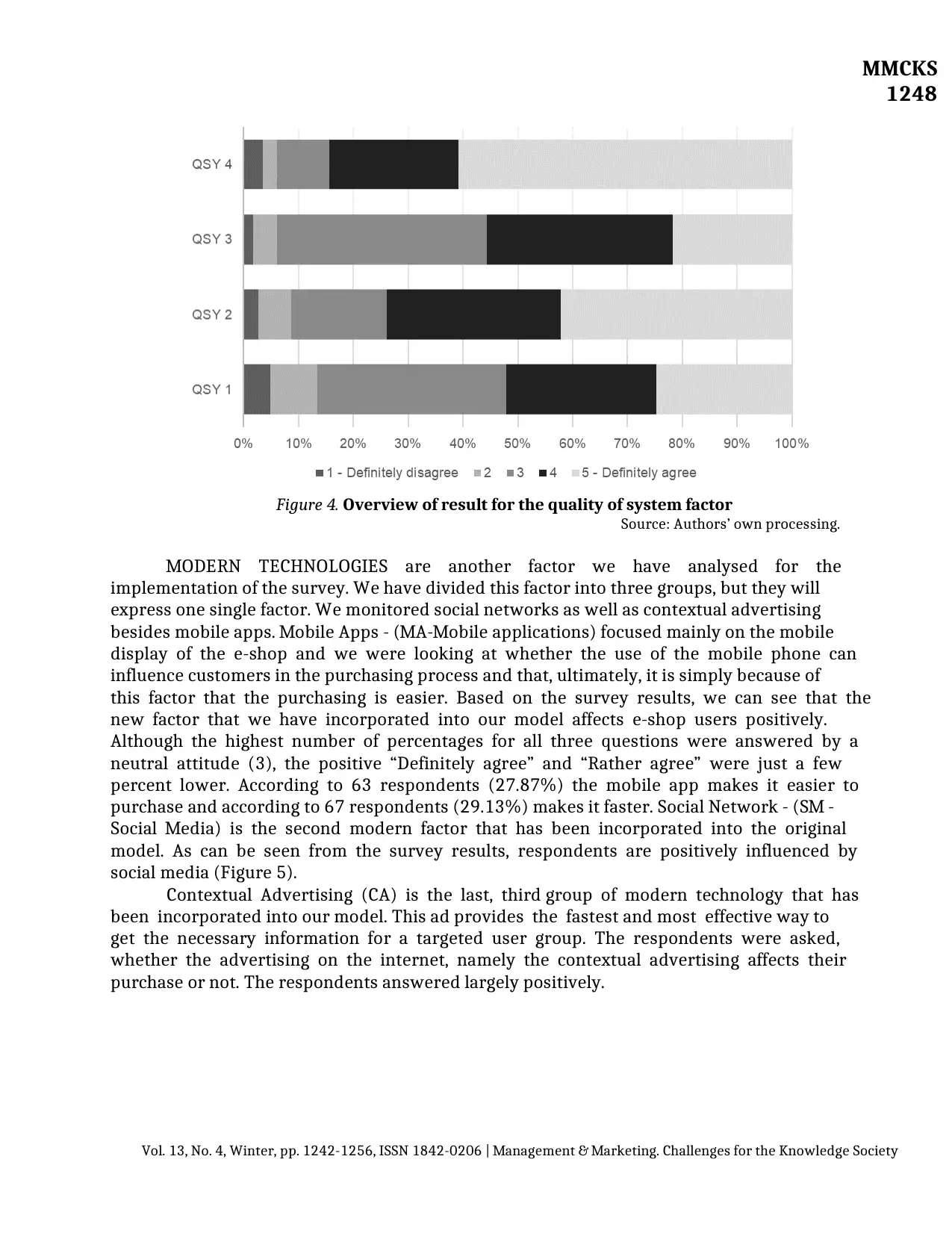
MMCKS
1248
Vol. 13, No. 4, Winter, pp. 1242-1256, ISSN 1842-0206 | Management & Marketing. Challenges for the Knowledge Society
Figure 4. Overview of result for the quality of system factor
Source: Authors’ own processing.
MODERN TECHNOLOGIES are another factor we have analysed for the
implementation of the survey. We have divided this factor into three groups, but they will
express one single factor. We monitored social networks as well as contextual advertising
besides mobile apps. Mobile Apps - (MA-Mobile applications) focused mainly on the mobile
display of the e-shop and we were looking at whether the use of the mobile phone can
influence customers in the purchasing process and that, ultimately, it is simply because of
this factor that the purchasing is easier. Based on the survey results, we can see that the
new factor that we have incorporated into our model affects e-shop users positively.
Although the highest number of percentages for all three questions were answered by a
neutral attitude (3), the positive “Definitely agree” and “Rather agree” were just a few
percent lower. According to 63 respondents (27.87%) the mobile app makes it easier to
purchase and according to 67 respondents (29.13%) makes it faster. Social Network - (SM -
Social Media) is the second modern factor that has been incorporated into the original
model. As can be seen from the survey results, respondents are positively influenced by
social media (Figure 5).
Contextual Advertising (CA) is the last, third group of modern technology that has
been incorporated into our model. This ad provides the fastest and most effective way to
get the necessary information for a targeted user group. The respondents were asked,
whether the advertising on the internet, namely the contextual advertising affects their
purchase or not. The respondents answered largely positively.
1248
Vol. 13, No. 4, Winter, pp. 1242-1256, ISSN 1842-0206 | Management & Marketing. Challenges for the Knowledge Society
Figure 4. Overview of result for the quality of system factor
Source: Authors’ own processing.
MODERN TECHNOLOGIES are another factor we have analysed for the
implementation of the survey. We have divided this factor into three groups, but they will
express one single factor. We monitored social networks as well as contextual advertising
besides mobile apps. Mobile Apps - (MA-Mobile applications) focused mainly on the mobile
display of the e-shop and we were looking at whether the use of the mobile phone can
influence customers in the purchasing process and that, ultimately, it is simply because of
this factor that the purchasing is easier. Based on the survey results, we can see that the
new factor that we have incorporated into our model affects e-shop users positively.
Although the highest number of percentages for all three questions were answered by a
neutral attitude (3), the positive “Definitely agree” and “Rather agree” were just a few
percent lower. According to 63 respondents (27.87%) the mobile app makes it easier to
purchase and according to 67 respondents (29.13%) makes it faster. Social Network - (SM -
Social Media) is the second modern factor that has been incorporated into the original
model. As can be seen from the survey results, respondents are positively influenced by
social media (Figure 5).
Contextual Advertising (CA) is the last, third group of modern technology that has
been incorporated into our model. This ad provides the fastest and most effective way to
get the necessary information for a targeted user group. The respondents were asked,
whether the advertising on the internet, namely the contextual advertising affects their
purchase or not. The respondents answered largely positively.
Paraphrase This Document
Need a fresh take? Get an instant paraphrase of this document with our AI Paraphraser
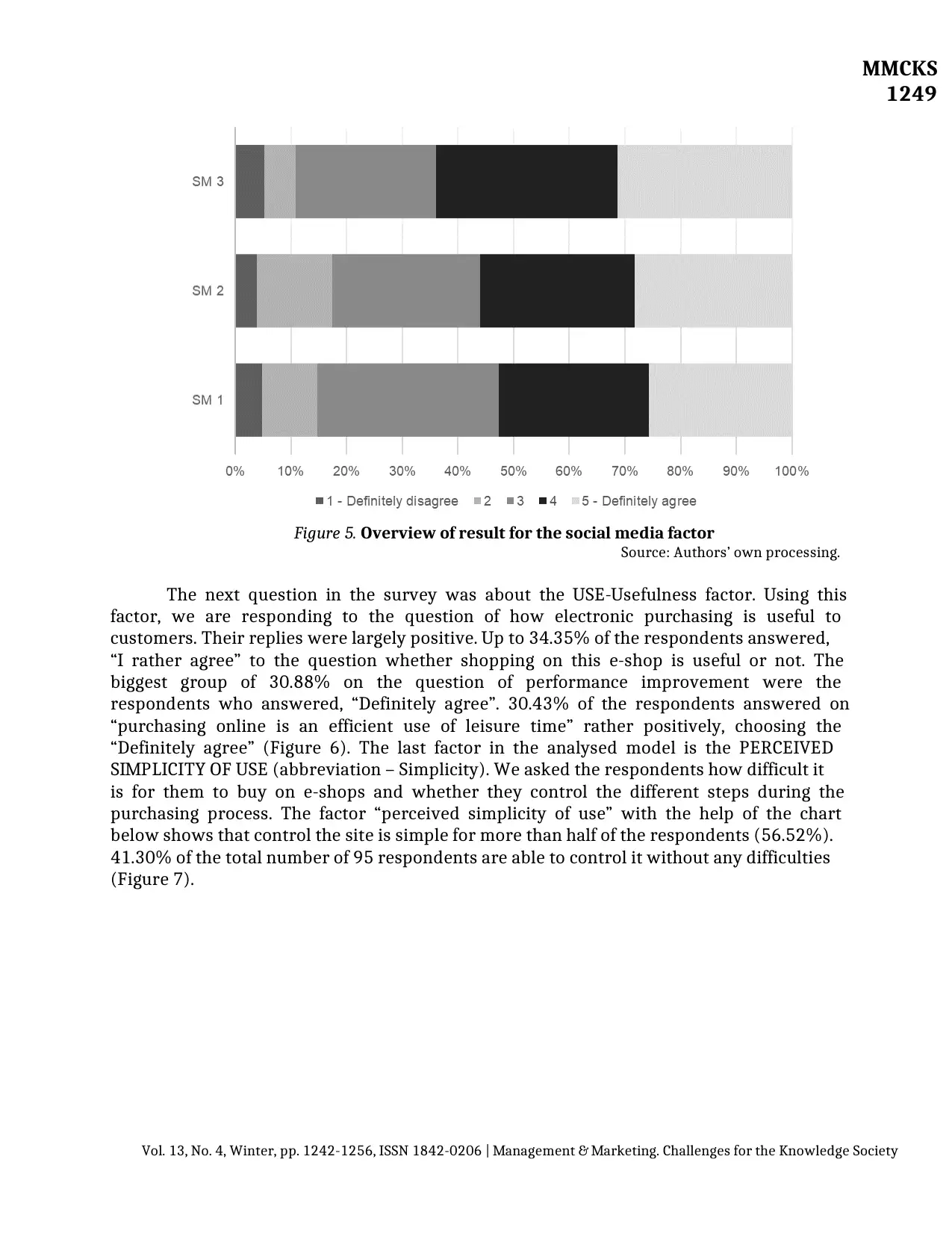
MMCKS
1249
Vol. 13, No. 4, Winter, pp. 1242-1256, ISSN 1842-0206 | Management & Marketing. Challenges for the Knowledge Society
Figure 5. Overview of result for the social media factor
Source: Authors’ own processing.
The next question in the survey was about the USE-Usefulness factor. Using this
factor, we are responding to the question of how electronic purchasing is useful to
customers. Their replies were largely positive. Up to 34.35% of the respondents answered,
“I rather agree” to the question whether shopping on this e-shop is useful or not. The
biggest group of 30.88% on the question of performance improvement were the
respondents who answered, “Definitely agree”. 30.43% of the respondents answered on
“purchasing online is an efficient use of leisure time” rather positively, choosing the
“Definitely agree” (Figure 6). The last factor in the analysed model is the PERCEIVED
SIMPLICITY OF USE (abbreviation – Simplicity). We asked the respondents how difficult it
is for them to buy on e-shops and whether they control the different steps during the
purchasing process. The factor “perceived simplicity of use” with the help of the chart
below shows that control the site is simple for more than half of the respondents (56.52%).
41.30% of the total number of 95 respondents are able to control it without any difficulties
(Figure 7).
1249
Vol. 13, No. 4, Winter, pp. 1242-1256, ISSN 1842-0206 | Management & Marketing. Challenges for the Knowledge Society
Figure 5. Overview of result for the social media factor
Source: Authors’ own processing.
The next question in the survey was about the USE-Usefulness factor. Using this
factor, we are responding to the question of how electronic purchasing is useful to
customers. Their replies were largely positive. Up to 34.35% of the respondents answered,
“I rather agree” to the question whether shopping on this e-shop is useful or not. The
biggest group of 30.88% on the question of performance improvement were the
respondents who answered, “Definitely agree”. 30.43% of the respondents answered on
“purchasing online is an efficient use of leisure time” rather positively, choosing the
“Definitely agree” (Figure 6). The last factor in the analysed model is the PERCEIVED
SIMPLICITY OF USE (abbreviation – Simplicity). We asked the respondents how difficult it
is for them to buy on e-shops and whether they control the different steps during the
purchasing process. The factor “perceived simplicity of use” with the help of the chart
below shows that control the site is simple for more than half of the respondents (56.52%).
41.30% of the total number of 95 respondents are able to control it without any difficulties
(Figure 7).
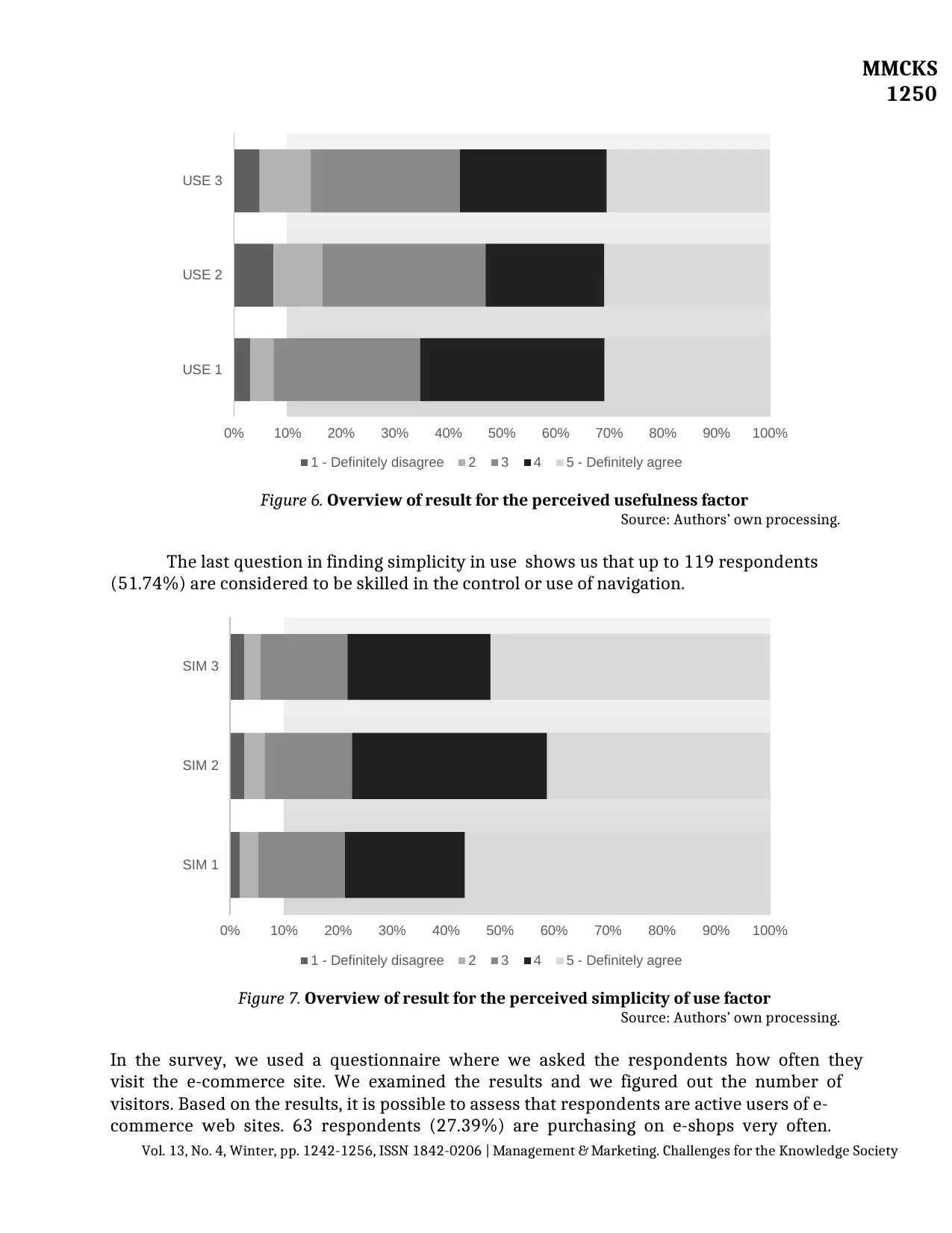
MMCKS
1250
Vol. 13, No. 4, Winter, pp. 1242-1256, ISSN 1842-0206 | Management & Marketing. Challenges for the Knowledge Society
0% 10% 20% 30% 40% 50% 60% 70% 80% 90% 100%
USE 1
USE 2
USE 3
1 - Definitely disagree 2 3 4 5 - Definitely agree
Figure 6. Overview of result for the perceived usefulness factor
Source: Authors’ own processing.
The last question in finding simplicity in use shows us that up to 119 respondents
(51.74%) are considered to be skilled in the control or use of navigation.
0% 10% 20% 30% 40% 50% 60% 70% 80% 90% 100%
SIM 1
SIM 2
SIM 3
1 - Definitely disagree 2 3 4 5 - Definitely agree
Figure 7. Overview of result for the perceived simplicity of use factor
Source: Authors’ own processing.
In the survey, we used a questionnaire where we asked the respondents how often they
visit the e-commerce site. We examined the results and we figured out the number of
visitors. Based on the results, it is possible to assess that respondents are active users of e-
commerce web sites. 63 respondents (27.39%) are purchasing on e-shops very often.
1250
Vol. 13, No. 4, Winter, pp. 1242-1256, ISSN 1842-0206 | Management & Marketing. Challenges for the Knowledge Society
0% 10% 20% 30% 40% 50% 60% 70% 80% 90% 100%
USE 1
USE 2
USE 3
1 - Definitely disagree 2 3 4 5 - Definitely agree
Figure 6. Overview of result for the perceived usefulness factor
Source: Authors’ own processing.
The last question in finding simplicity in use shows us that up to 119 respondents
(51.74%) are considered to be skilled in the control or use of navigation.
0% 10% 20% 30% 40% 50% 60% 70% 80% 90% 100%
SIM 1
SIM 2
SIM 3
1 - Definitely disagree 2 3 4 5 - Definitely agree
Figure 7. Overview of result for the perceived simplicity of use factor
Source: Authors’ own processing.
In the survey, we used a questionnaire where we asked the respondents how often they
visit the e-commerce site. We examined the results and we figured out the number of
visitors. Based on the results, it is possible to assess that respondents are active users of e-
commerce web sites. 63 respondents (27.39%) are purchasing on e-shops very often.
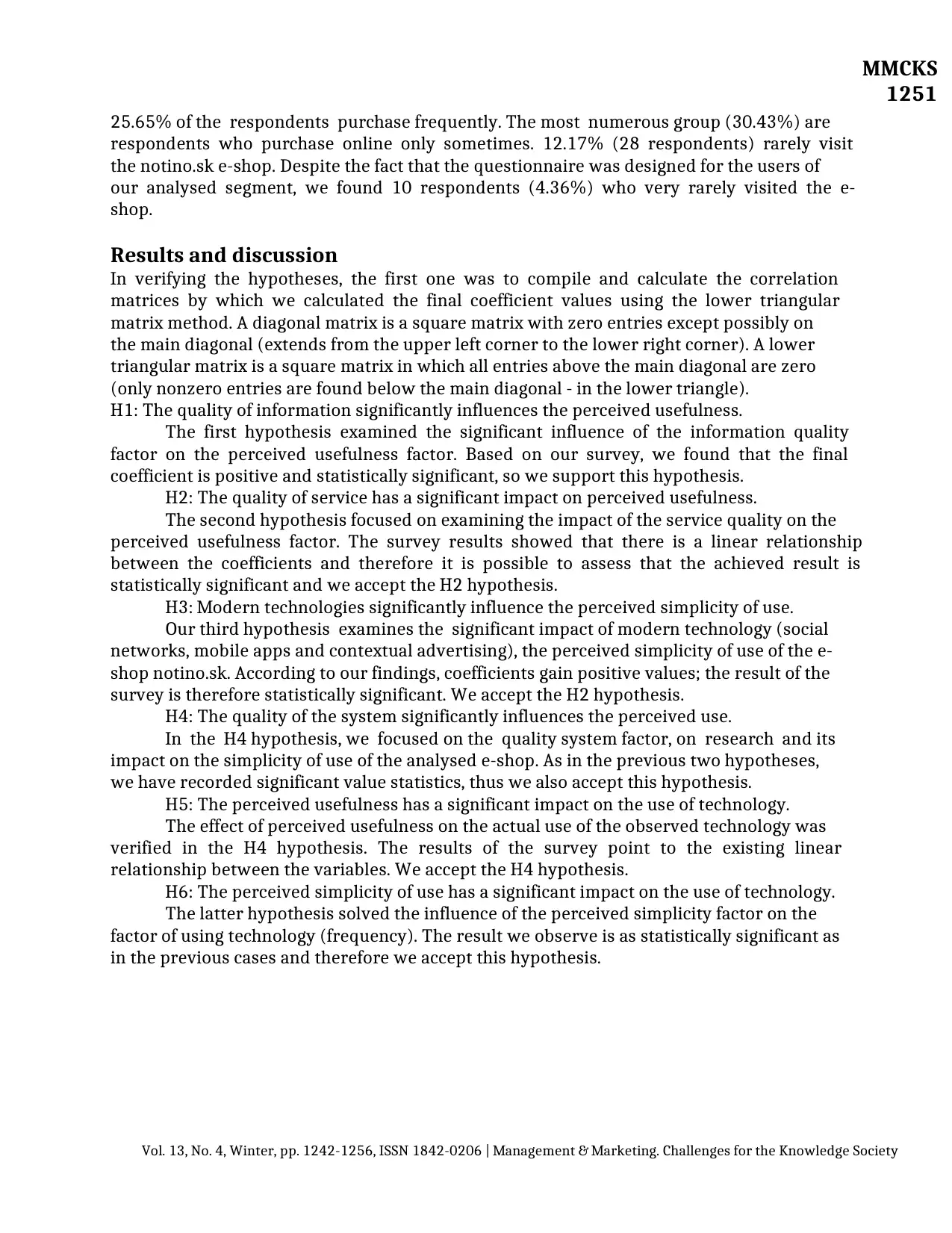
MMCKS
1251
Vol. 13, No. 4, Winter, pp. 1242-1256, ISSN 1842-0206 | Management & Marketing. Challenges for the Knowledge Society
25.65% of the respondents purchase frequently. The most numerous group (30.43%) are
respondents who purchase online only sometimes. 12.17% (28 respondents) rarely visit
the notino.sk e-shop. Despite the fact that the questionnaire was designed for the users of
our analysed segment, we found 10 respondents (4.36%) who very rarely visited the e-
shop.
Results and discussion
In verifying the hypotheses, the first one was to compile and calculate the correlation
matrices by which we calculated the final coefficient values using the lower triangular
matrix method. A diagonal matrix is a square matrix with zero entries except possibly on
the main diagonal (extends from the upper left corner to the lower right corner). A lower
triangular matrix is a square matrix in which all entries above the main diagonal are zero
(only nonzero entries are found below the main diagonal - in the lower triangle).
H1: The quality of information significantly influences the perceived usefulness.
The first hypothesis examined the significant influence of the information quality
factor on the perceived usefulness factor. Based on our survey, we found that the final
coefficient is positive and statistically significant, so we support this hypothesis.
H2: The quality of service has a significant impact on perceived usefulness.
The second hypothesis focused on examining the impact of the service quality on the
perceived usefulness factor. The survey results showed that there is a linear relationship
between the coefficients and therefore it is possible to assess that the achieved result is
statistically significant and we accept the H2 hypothesis.
H3: Modern technologies significantly influence the perceived simplicity of use.
Our third hypothesis examines the significant impact of modern technology (social
networks, mobile apps and contextual advertising), the perceived simplicity of use of the e-
shop notino.sk. According to our findings, coefficients gain positive values; the result of the
survey is therefore statistically significant. We accept the H2 hypothesis.
H4: The quality of the system significantly influences the perceived use.
In the H4 hypothesis, we focused on the quality system factor, on research and its
impact on the simplicity of use of the analysed e-shop. As in the previous two hypotheses,
we have recorded significant value statistics, thus we also accept this hypothesis.
H5: The perceived usefulness has a significant impact on the use of technology.
The effect of perceived usefulness on the actual use of the observed technology was
verified in the H4 hypothesis. The results of the survey point to the existing linear
relationship between the variables. We accept the H4 hypothesis.
H6: The perceived simplicity of use has a significant impact on the use of technology.
The latter hypothesis solved the influence of the perceived simplicity factor on the
factor of using technology (frequency). The result we observe is as statistically significant as
in the previous cases and therefore we accept this hypothesis.
1251
Vol. 13, No. 4, Winter, pp. 1242-1256, ISSN 1842-0206 | Management & Marketing. Challenges for the Knowledge Society
25.65% of the respondents purchase frequently. The most numerous group (30.43%) are
respondents who purchase online only sometimes. 12.17% (28 respondents) rarely visit
the notino.sk e-shop. Despite the fact that the questionnaire was designed for the users of
our analysed segment, we found 10 respondents (4.36%) who very rarely visited the e-
shop.
Results and discussion
In verifying the hypotheses, the first one was to compile and calculate the correlation
matrices by which we calculated the final coefficient values using the lower triangular
matrix method. A diagonal matrix is a square matrix with zero entries except possibly on
the main diagonal (extends from the upper left corner to the lower right corner). A lower
triangular matrix is a square matrix in which all entries above the main diagonal are zero
(only nonzero entries are found below the main diagonal - in the lower triangle).
H1: The quality of information significantly influences the perceived usefulness.
The first hypothesis examined the significant influence of the information quality
factor on the perceived usefulness factor. Based on our survey, we found that the final
coefficient is positive and statistically significant, so we support this hypothesis.
H2: The quality of service has a significant impact on perceived usefulness.
The second hypothesis focused on examining the impact of the service quality on the
perceived usefulness factor. The survey results showed that there is a linear relationship
between the coefficients and therefore it is possible to assess that the achieved result is
statistically significant and we accept the H2 hypothesis.
H3: Modern technologies significantly influence the perceived simplicity of use.
Our third hypothesis examines the significant impact of modern technology (social
networks, mobile apps and contextual advertising), the perceived simplicity of use of the e-
shop notino.sk. According to our findings, coefficients gain positive values; the result of the
survey is therefore statistically significant. We accept the H2 hypothesis.
H4: The quality of the system significantly influences the perceived use.
In the H4 hypothesis, we focused on the quality system factor, on research and its
impact on the simplicity of use of the analysed e-shop. As in the previous two hypotheses,
we have recorded significant value statistics, thus we also accept this hypothesis.
H5: The perceived usefulness has a significant impact on the use of technology.
The effect of perceived usefulness on the actual use of the observed technology was
verified in the H4 hypothesis. The results of the survey point to the existing linear
relationship between the variables. We accept the H4 hypothesis.
H6: The perceived simplicity of use has a significant impact on the use of technology.
The latter hypothesis solved the influence of the perceived simplicity factor on the
factor of using technology (frequency). The result we observe is as statistically significant as
in the previous cases and therefore we accept this hypothesis.
Secure Best Marks with AI Grader
Need help grading? Try our AI Grader for instant feedback on your assignments.
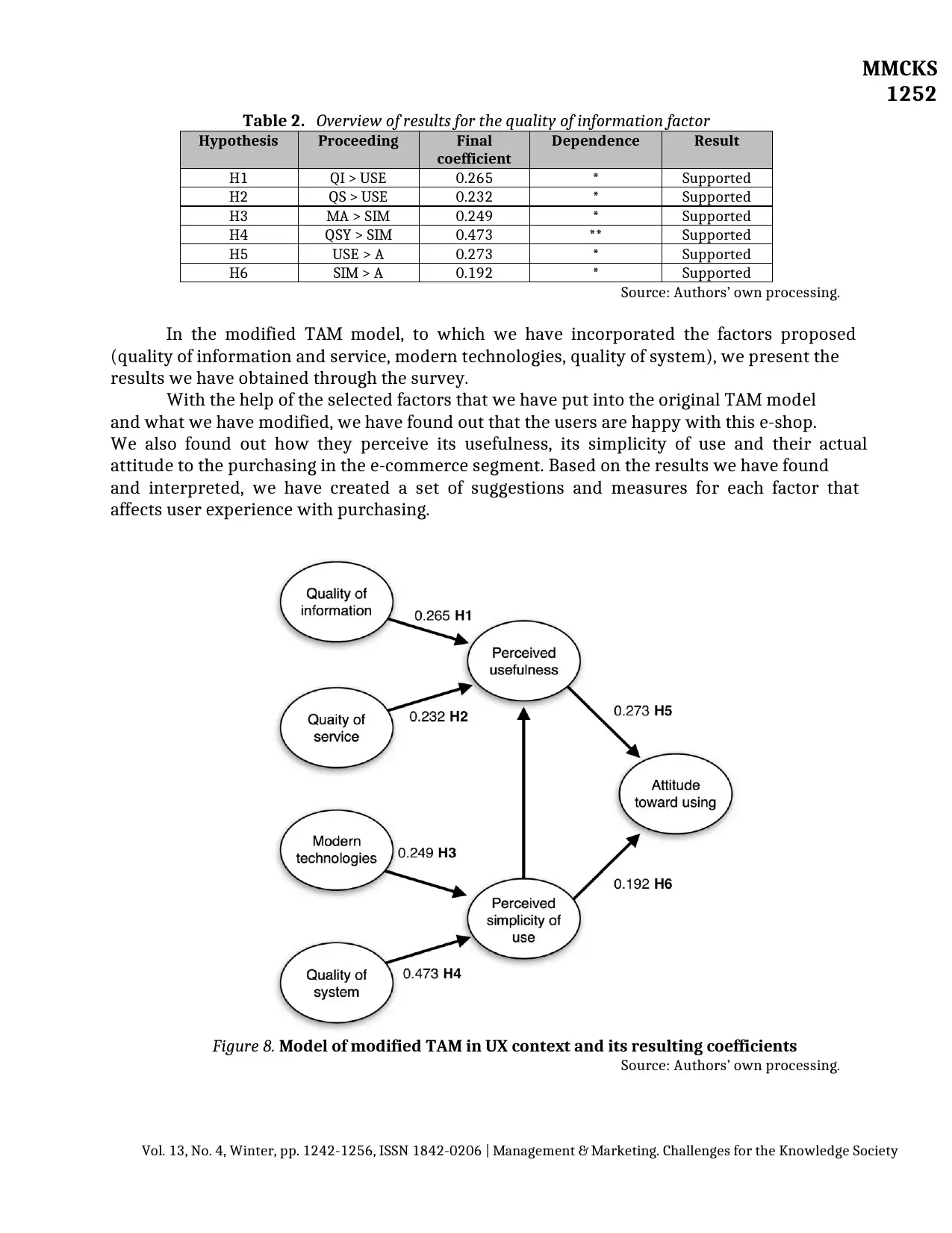
MMCKS
1252
Vol. 13, No. 4, Winter, pp. 1242-1256, ISSN 1842-0206 | Management & Marketing. Challenges for the Knowledge Society
Table 2. Overview of results for the quality of information factor
Hypothesis Proceeding Final
coefficient
Dependence Result
H1 QI > USE 0.265 * Supported
H2 QS > USE 0.232 * Supported
H3 MA > SIM 0.249 * Supported
H4 QSY > SIM 0.473 ** Supported
H5 USE > A 0.273 * Supported
H6 SIM > A 0.192 * Supported
Source: Authors’ own processing.
In the modified TAM model, to which we have incorporated the factors proposed
(quality of information and service, modern technologies, quality of system), we present the
results we have obtained through the survey.
With the help of the selected factors that we have put into the original TAM model
and what we have modified, we have found out that the users are happy with this e-shop.
We also found out how they perceive its usefulness, its simplicity of use and their actual
attitude to the purchasing in the e-commerce segment. Based on the results we have found
and interpreted, we have created a set of suggestions and measures for each factor that
affects user experience with purchasing.
Figure 8. Model of modified TAM in UX context and its resulting coefficients
Source: Authors’ own processing.
1252
Vol. 13, No. 4, Winter, pp. 1242-1256, ISSN 1842-0206 | Management & Marketing. Challenges for the Knowledge Society
Table 2. Overview of results for the quality of information factor
Hypothesis Proceeding Final
coefficient
Dependence Result
H1 QI > USE 0.265 * Supported
H2 QS > USE 0.232 * Supported
H3 MA > SIM 0.249 * Supported
H4 QSY > SIM 0.473 ** Supported
H5 USE > A 0.273 * Supported
H6 SIM > A 0.192 * Supported
Source: Authors’ own processing.
In the modified TAM model, to which we have incorporated the factors proposed
(quality of information and service, modern technologies, quality of system), we present the
results we have obtained through the survey.
With the help of the selected factors that we have put into the original TAM model
and what we have modified, we have found out that the users are happy with this e-shop.
We also found out how they perceive its usefulness, its simplicity of use and their actual
attitude to the purchasing in the e-commerce segment. Based on the results we have found
and interpreted, we have created a set of suggestions and measures for each factor that
affects user experience with purchasing.
Figure 8. Model of modified TAM in UX context and its resulting coefficients
Source: Authors’ own processing.
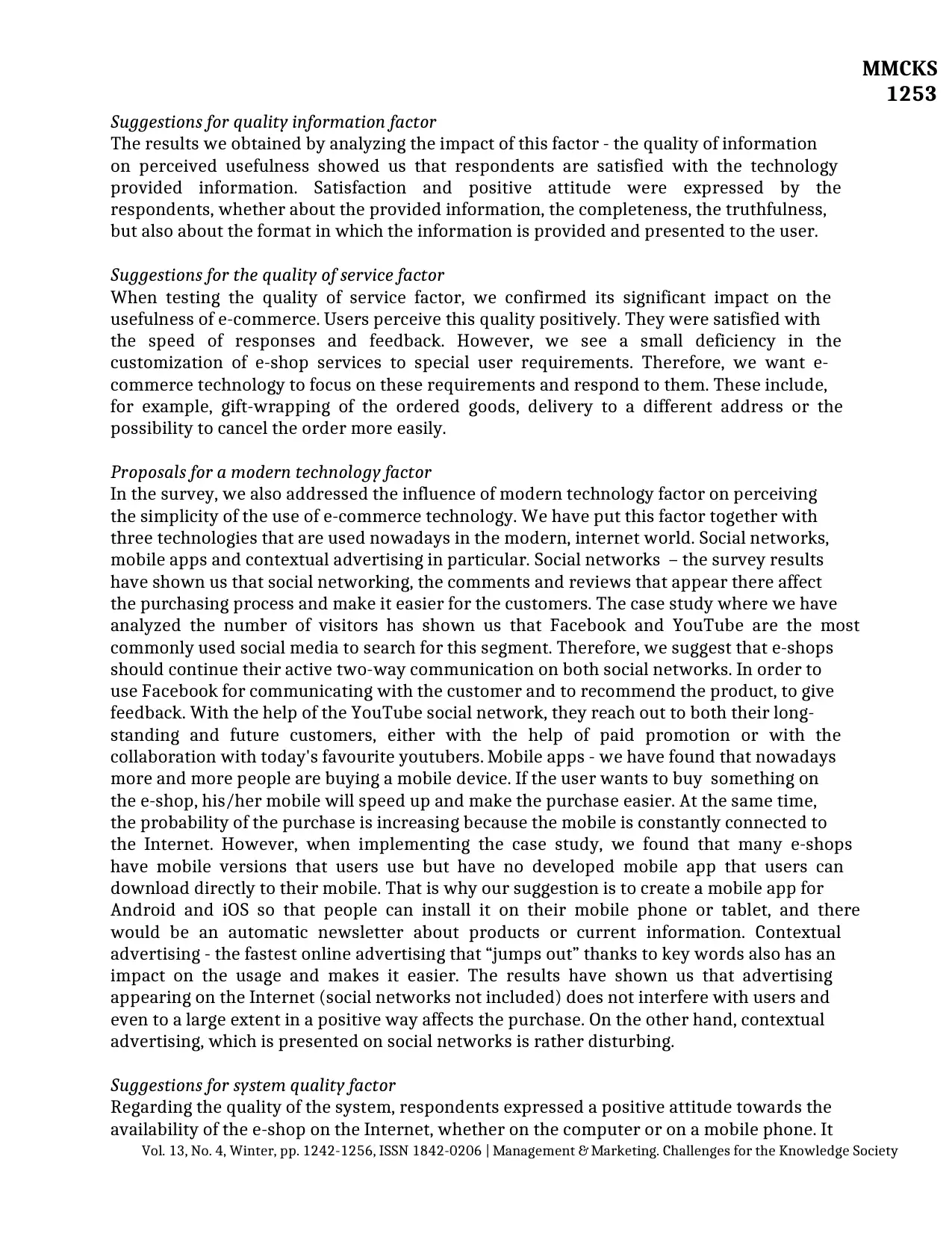
MMCKS
1253
Vol. 13, No. 4, Winter, pp. 1242-1256, ISSN 1842-0206 | Management & Marketing. Challenges for the Knowledge Society
Suggestions for quality information factor
The results we obtained by analyzing the impact of this factor - the quality of information
on perceived usefulness showed us that respondents are satisfied with the technology
provided information. Satisfaction and positive attitude were expressed by the
respondents, whether about the provided information, the completeness, the truthfulness,
but also about the format in which the information is provided and presented to the user.
Suggestions for the quality of service factor
When testing the quality of service factor, we confirmed its significant impact on the
usefulness of e-commerce. Users perceive this quality positively. They were satisfied with
the speed of responses and feedback. However, we see a small deficiency in the
customization of e-shop services to special user requirements. Therefore, we want e-
commerce technology to focus on these requirements and respond to them. These include,
for example, gift-wrapping of the ordered goods, delivery to a different address or the
possibility to cancel the order more easily.
Proposals for a modern technology factor
In the survey, we also addressed the influence of modern technology factor on perceiving
the simplicity of the use of e-commerce technology. We have put this factor together with
three technologies that are used nowadays in the modern, internet world. Social networks,
mobile apps and contextual advertising in particular. Social networks – the survey results
have shown us that social networking, the comments and reviews that appear there affect
the purchasing process and make it easier for the customers. The case study where we have
analyzed the number of visitors has shown us that Facebook and YouTube are the most
commonly used social media to search for this segment. Therefore, we suggest that e-shops
should continue their active two-way communication on both social networks. In order to
use Facebook for communicating with the customer and to recommend the product, to give
feedback. With the help of the YouTube social network, they reach out to both their long-
standing and future customers, either with the help of paid promotion or with the
collaboration with today's favourite youtubers. Mobile apps - we have found that nowadays
more and more people are buying a mobile device. If the user wants to buy something on
the e-shop, his/her mobile will speed up and make the purchase easier. At the same time,
the probability of the purchase is increasing because the mobile is constantly connected to
the Internet. However, when implementing the case study, we found that many e-shops
have mobile versions that users use but have no developed mobile app that users can
download directly to their mobile. That is why our suggestion is to create a mobile app for
Android and iOS so that people can install it on their mobile phone or tablet, and there
would be an automatic newsletter about products or current information. Contextual
advertising - the fastest online advertising that “jumps out” thanks to key words also has an
impact on the usage and makes it easier. The results have shown us that advertising
appearing on the Internet (social networks not included) does not interfere with users and
even to a large extent in a positive way affects the purchase. On the other hand, contextual
advertising, which is presented on social networks is rather disturbing.
Suggestions for system quality factor
Regarding the quality of the system, respondents expressed a positive attitude towards the
availability of the e-shop on the Internet, whether on the computer or on a mobile phone. It
1253
Vol. 13, No. 4, Winter, pp. 1242-1256, ISSN 1842-0206 | Management & Marketing. Challenges for the Knowledge Society
Suggestions for quality information factor
The results we obtained by analyzing the impact of this factor - the quality of information
on perceived usefulness showed us that respondents are satisfied with the technology
provided information. Satisfaction and positive attitude were expressed by the
respondents, whether about the provided information, the completeness, the truthfulness,
but also about the format in which the information is provided and presented to the user.
Suggestions for the quality of service factor
When testing the quality of service factor, we confirmed its significant impact on the
usefulness of e-commerce. Users perceive this quality positively. They were satisfied with
the speed of responses and feedback. However, we see a small deficiency in the
customization of e-shop services to special user requirements. Therefore, we want e-
commerce technology to focus on these requirements and respond to them. These include,
for example, gift-wrapping of the ordered goods, delivery to a different address or the
possibility to cancel the order more easily.
Proposals for a modern technology factor
In the survey, we also addressed the influence of modern technology factor on perceiving
the simplicity of the use of e-commerce technology. We have put this factor together with
three technologies that are used nowadays in the modern, internet world. Social networks,
mobile apps and contextual advertising in particular. Social networks – the survey results
have shown us that social networking, the comments and reviews that appear there affect
the purchasing process and make it easier for the customers. The case study where we have
analyzed the number of visitors has shown us that Facebook and YouTube are the most
commonly used social media to search for this segment. Therefore, we suggest that e-shops
should continue their active two-way communication on both social networks. In order to
use Facebook for communicating with the customer and to recommend the product, to give
feedback. With the help of the YouTube social network, they reach out to both their long-
standing and future customers, either with the help of paid promotion or with the
collaboration with today's favourite youtubers. Mobile apps - we have found that nowadays
more and more people are buying a mobile device. If the user wants to buy something on
the e-shop, his/her mobile will speed up and make the purchase easier. At the same time,
the probability of the purchase is increasing because the mobile is constantly connected to
the Internet. However, when implementing the case study, we found that many e-shops
have mobile versions that users use but have no developed mobile app that users can
download directly to their mobile. That is why our suggestion is to create a mobile app for
Android and iOS so that people can install it on their mobile phone or tablet, and there
would be an automatic newsletter about products or current information. Contextual
advertising - the fastest online advertising that “jumps out” thanks to key words also has an
impact on the usage and makes it easier. The results have shown us that advertising
appearing on the Internet (social networks not included) does not interfere with users and
even to a large extent in a positive way affects the purchase. On the other hand, contextual
advertising, which is presented on social networks is rather disturbing.
Suggestions for system quality factor
Regarding the quality of the system, respondents expressed a positive attitude towards the
availability of the e-shop on the Internet, whether on the computer or on a mobile phone. It
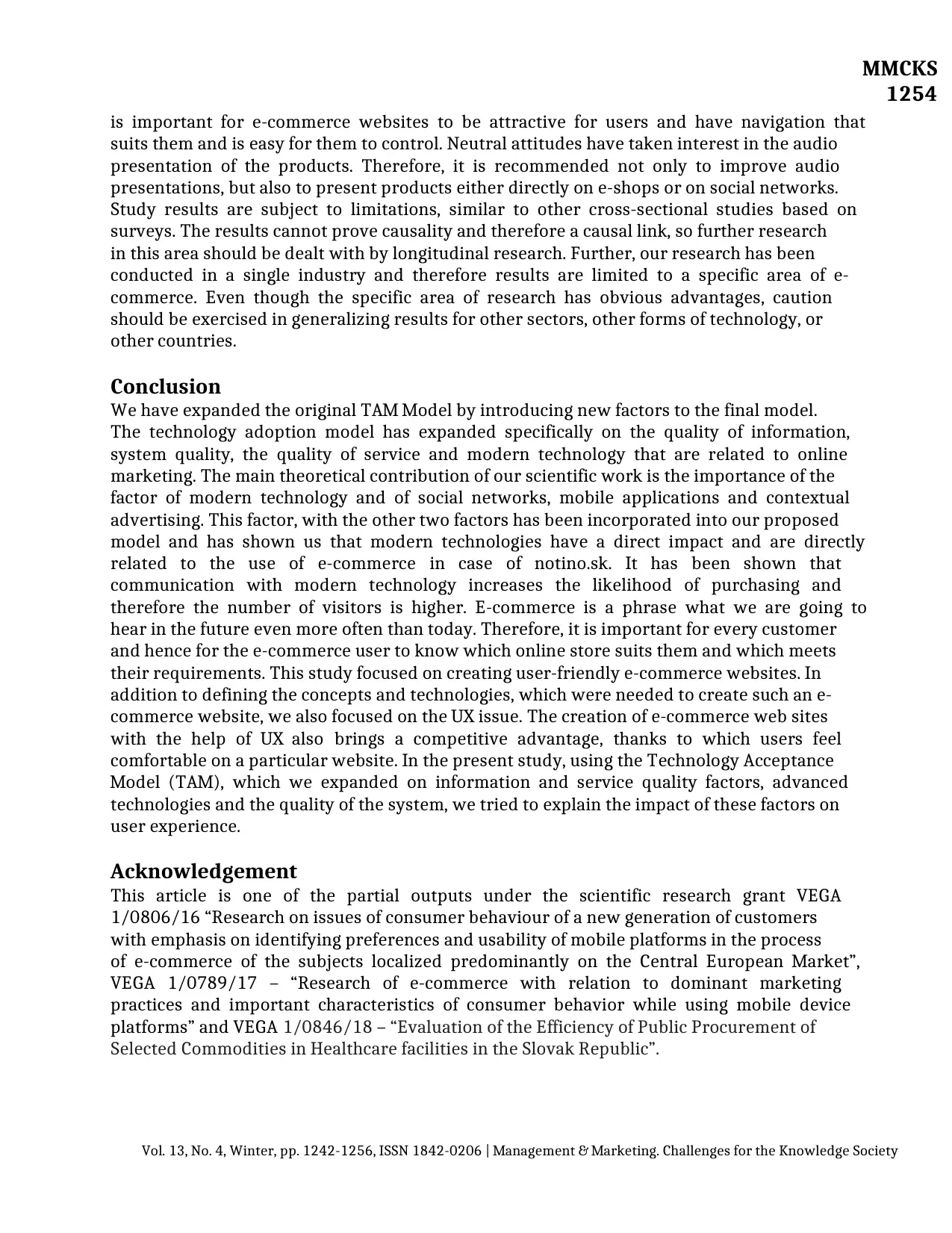
MMCKS
1254
Vol. 13, No. 4, Winter, pp. 1242-1256, ISSN 1842-0206 | Management & Marketing. Challenges for the Knowledge Society
is important for e-commerce websites to be attractive for users and have navigation that
suits them and is easy for them to control. Neutral attitudes have taken interest in the audio
presentation of the products. Therefore, it is recommended not only to improve audio
presentations, but also to present products either directly on e-shops or on social networks.
Study results are subject to limitations, similar to other cross-sectional studies based on
surveys. The results cannot prove causality and therefore a causal link, so further research
in this area should be dealt with by longitudinal research. Further, our research has been
conducted in a single industry and therefore results are limited to a specific area of e-
commerce. Even though the specific area of research has obvious advantages, caution
should be exercised in generalizing results for other sectors, other forms of technology, or
other countries.
Conclusion
We have expanded the original TAM Model by introducing new factors to the final model.
The technology adoption model has expanded specifically on the quality of information,
system quality, the quality of service and modern technology that are related to online
marketing. The main theoretical contribution of our scientific work is the importance of the
factor of modern technology and of social networks, mobile applications and contextual
advertising. This factor, with the other two factors has been incorporated into our proposed
model and has shown us that modern technologies have a direct impact and are directly
related to the use of e-commerce in case of notino.sk. It has been shown that
communication with modern technology increases the likelihood of purchasing and
therefore the number of visitors is higher. E-commerce is a phrase what we are going to
hear in the future even more often than today. Therefore, it is important for every customer
and hence for the e-commerce user to know which online store suits them and which meets
their requirements. This study focused on creating user-friendly e-commerce websites. In
addition to defining the concepts and technologies, which were needed to create such an e-
commerce website, we also focused on the UX issue. The creation of e-commerce web sites
with the help of UX also brings a competitive advantage, thanks to which users feel
comfortable on a particular website. In the present study, using the Technology Acceptance
Model (TAM), which we expanded on information and service quality factors, advanced
technologies and the quality of the system, we tried to explain the impact of these factors on
user experience.
Acknowledgement
This article is one of the partial outputs under the scientific research grant VEGA
1/0806/16 “Research on issues of consumer behaviour of a new generation of customers
with emphasis on identifying preferences and usability of mobile platforms in the process
of e-commerce of the subjects localized predominantly on the Central European Market”,
VEGA 1/0789/17 – “Research of e-commerce with relation to dominant marketing
practices and important characteristics of consumer behavior while using mobile device
platforms” and VEGA 1/0846/18 – “Evaluation of the Efficiency of Public Procurement of
Selected Commodities in Healthcare facilities in the Slovak Republic”.
1254
Vol. 13, No. 4, Winter, pp. 1242-1256, ISSN 1842-0206 | Management & Marketing. Challenges for the Knowledge Society
is important for e-commerce websites to be attractive for users and have navigation that
suits them and is easy for them to control. Neutral attitudes have taken interest in the audio
presentation of the products. Therefore, it is recommended not only to improve audio
presentations, but also to present products either directly on e-shops or on social networks.
Study results are subject to limitations, similar to other cross-sectional studies based on
surveys. The results cannot prove causality and therefore a causal link, so further research
in this area should be dealt with by longitudinal research. Further, our research has been
conducted in a single industry and therefore results are limited to a specific area of e-
commerce. Even though the specific area of research has obvious advantages, caution
should be exercised in generalizing results for other sectors, other forms of technology, or
other countries.
Conclusion
We have expanded the original TAM Model by introducing new factors to the final model.
The technology adoption model has expanded specifically on the quality of information,
system quality, the quality of service and modern technology that are related to online
marketing. The main theoretical contribution of our scientific work is the importance of the
factor of modern technology and of social networks, mobile applications and contextual
advertising. This factor, with the other two factors has been incorporated into our proposed
model and has shown us that modern technologies have a direct impact and are directly
related to the use of e-commerce in case of notino.sk. It has been shown that
communication with modern technology increases the likelihood of purchasing and
therefore the number of visitors is higher. E-commerce is a phrase what we are going to
hear in the future even more often than today. Therefore, it is important for every customer
and hence for the e-commerce user to know which online store suits them and which meets
their requirements. This study focused on creating user-friendly e-commerce websites. In
addition to defining the concepts and technologies, which were needed to create such an e-
commerce website, we also focused on the UX issue. The creation of e-commerce web sites
with the help of UX also brings a competitive advantage, thanks to which users feel
comfortable on a particular website. In the present study, using the Technology Acceptance
Model (TAM), which we expanded on information and service quality factors, advanced
technologies and the quality of the system, we tried to explain the impact of these factors on
user experience.
Acknowledgement
This article is one of the partial outputs under the scientific research grant VEGA
1/0806/16 “Research on issues of consumer behaviour of a new generation of customers
with emphasis on identifying preferences and usability of mobile platforms in the process
of e-commerce of the subjects localized predominantly on the Central European Market”,
VEGA 1/0789/17 – “Research of e-commerce with relation to dominant marketing
practices and important characteristics of consumer behavior while using mobile device
platforms” and VEGA 1/0846/18 – “Evaluation of the Efficiency of Public Procurement of
Selected Commodities in Healthcare facilities in the Slovak Republic”.
Paraphrase This Document
Need a fresh take? Get an instant paraphrase of this document with our AI Paraphraser
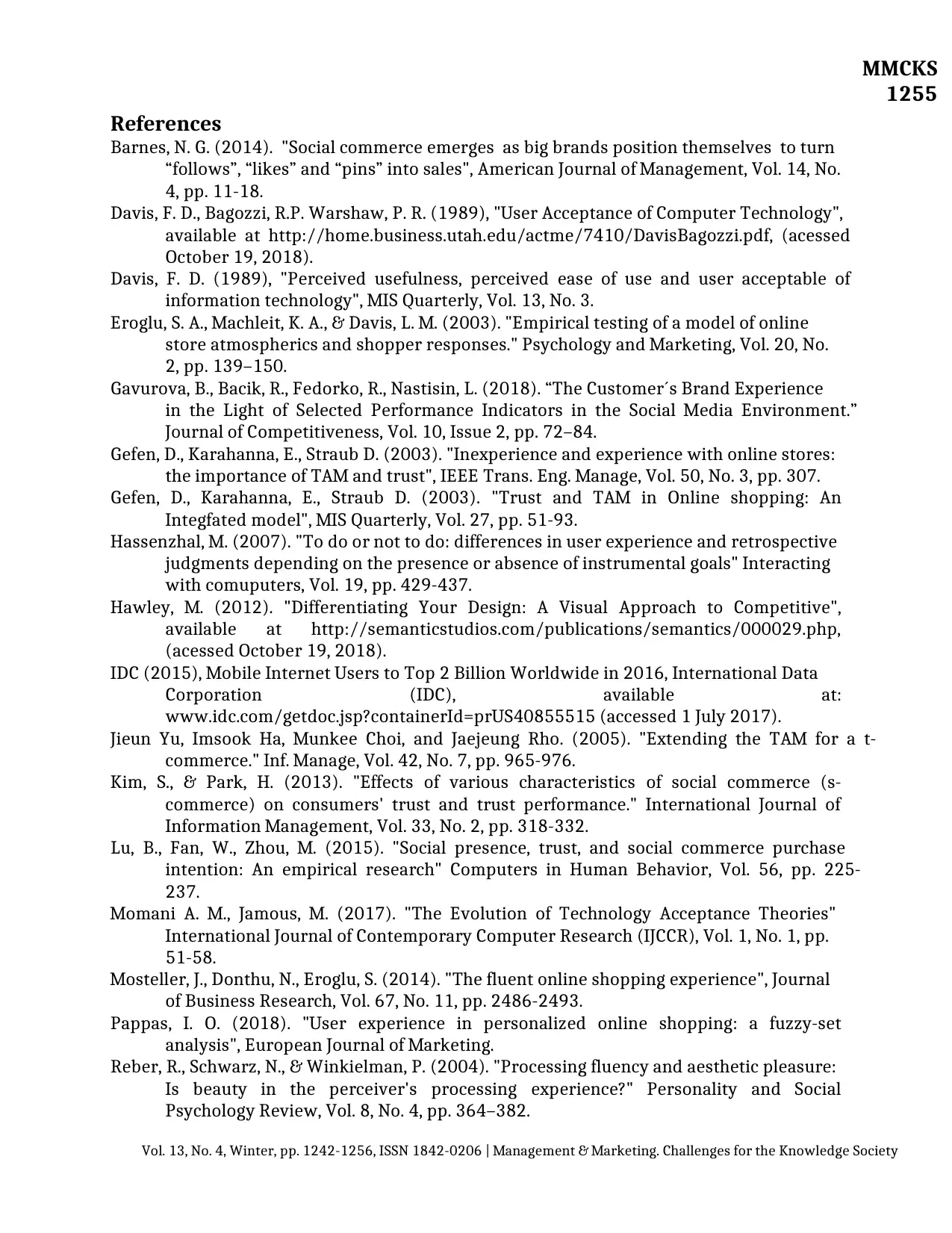
MMCKS
1255
Vol. 13, No. 4, Winter, pp. 1242-1256, ISSN 1842-0206 | Management & Marketing. Challenges for the Knowledge Society
References
Barnes, N. G. (2014). "Social commerce emerges as big brands position themselves to turn
“follows”, “likes” and “pins” into sales", American Journal of Management, Vol. 14, No.
4, pp. 11-18.
Davis, F. D., Bagozzi, R.P. Warshaw, P. R. (1989), "User Acceptance of Computer Technology",
available at http://home.business.utah.edu/actme/7410/DavisBagozzi.pdf, (acessed
October 19, 2018).
Davis, F. D. (1989), "Perceived usefulness, perceived ease of use and user acceptable of
information technology", MIS Quarterly, Vol. 13, No. 3.
Eroglu, S. A., Machleit, K. A., & Davis, L. M. (2003). "Empirical testing of a model of online
store atmospherics and shopper responses." Psychology and Marketing, Vol. 20, No.
2, pp. 139–150.
Gavurova, B., Bacik, R., Fedorko, R., Nastisin, L. (2018). “The Customer´s Brand Experience
in the Light of Selected Performance Indicators in the Social Media Environment.”
Journal of Competitiveness, Vol. 10, Issue 2, pp. 72–84.
Gefen, D., Karahanna, E., Straub D. (2003). "Inexperience and experience with online stores:
the importance of TAM and trust", IEEE Trans. Eng. Manage, Vol. 50, No. 3, pp. 307.
Gefen, D., Karahanna, E., Straub D. (2003). "Trust and TAM in Online shopping: An
Integfated model", MIS Quarterly, Vol. 27, pp. 51-93.
Hassenzhal, M. (2007). "To do or not to do: differences in user experience and retrospective
judgments depending on the presence or absence of instrumental goals" Interacting
with comuputers, Vol. 19, pp. 429-437.
Hawley, M. (2012). "Differentiating Your Design: A Visual Approach to Competitive",
available at http://semanticstudios.com/publications/semantics/000029.php,
(acessed October 19, 2018).
IDC (2015), Mobile Internet Users to Top 2 Billion Worldwide in 2016, International Data
Corporation (IDC), available at:
www.idc.com/getdoc.jsp?containerId=prUS40855515 (accessed 1 July 2017).
Jieun Yu, Imsook Ha, Munkee Choi, and Jaejeung Rho. (2005). "Extending the TAM for a t-
commerce." Inf. Manage, Vol. 42, No. 7, pp. 965-976.
Kim, S., & Park, H. (2013). "Effects of various characteristics of social commerce (s-
commerce) on consumers' trust and trust performance." International Journal of
Information Management, Vol. 33, No. 2, pp. 318-332.
Lu, B., Fan, W., Zhou, M. (2015). "Social presence, trust, and social commerce purchase
intention: An empirical research" Computers in Human Behavior, Vol. 56, pp. 225-
237.
Momani A. M., Jamous, M. (2017). "The Evolution of Technology Acceptance Theories"
International Journal of Contemporary Computer Research (IJCCR), Vol. 1, No. 1, pp.
51-58.
Mosteller, J., Donthu, N., Eroglu, S. (2014). "The fluent online shopping experience", Journal
of Business Research, Vol. 67, No. 11, pp. 2486-2493.
Pappas, I. O. (2018). "User experience in personalized online shopping: a fuzzy-set
analysis", European Journal of Marketing.
Reber, R., Schwarz, N., & Winkielman, P. (2004). "Processing fluency and aesthetic pleasure:
Is beauty in the perceiver's processing experience?" Personality and Social
Psychology Review, Vol. 8, No. 4, pp. 364–382.
1255
Vol. 13, No. 4, Winter, pp. 1242-1256, ISSN 1842-0206 | Management & Marketing. Challenges for the Knowledge Society
References
Barnes, N. G. (2014). "Social commerce emerges as big brands position themselves to turn
“follows”, “likes” and “pins” into sales", American Journal of Management, Vol. 14, No.
4, pp. 11-18.
Davis, F. D., Bagozzi, R.P. Warshaw, P. R. (1989), "User Acceptance of Computer Technology",
available at http://home.business.utah.edu/actme/7410/DavisBagozzi.pdf, (acessed
October 19, 2018).
Davis, F. D. (1989), "Perceived usefulness, perceived ease of use and user acceptable of
information technology", MIS Quarterly, Vol. 13, No. 3.
Eroglu, S. A., Machleit, K. A., & Davis, L. M. (2003). "Empirical testing of a model of online
store atmospherics and shopper responses." Psychology and Marketing, Vol. 20, No.
2, pp. 139–150.
Gavurova, B., Bacik, R., Fedorko, R., Nastisin, L. (2018). “The Customer´s Brand Experience
in the Light of Selected Performance Indicators in the Social Media Environment.”
Journal of Competitiveness, Vol. 10, Issue 2, pp. 72–84.
Gefen, D., Karahanna, E., Straub D. (2003). "Inexperience and experience with online stores:
the importance of TAM and trust", IEEE Trans. Eng. Manage, Vol. 50, No. 3, pp. 307.
Gefen, D., Karahanna, E., Straub D. (2003). "Trust and TAM in Online shopping: An
Integfated model", MIS Quarterly, Vol. 27, pp. 51-93.
Hassenzhal, M. (2007). "To do or not to do: differences in user experience and retrospective
judgments depending on the presence or absence of instrumental goals" Interacting
with comuputers, Vol. 19, pp. 429-437.
Hawley, M. (2012). "Differentiating Your Design: A Visual Approach to Competitive",
available at http://semanticstudios.com/publications/semantics/000029.php,
(acessed October 19, 2018).
IDC (2015), Mobile Internet Users to Top 2 Billion Worldwide in 2016, International Data
Corporation (IDC), available at:
www.idc.com/getdoc.jsp?containerId=prUS40855515 (accessed 1 July 2017).
Jieun Yu, Imsook Ha, Munkee Choi, and Jaejeung Rho. (2005). "Extending the TAM for a t-
commerce." Inf. Manage, Vol. 42, No. 7, pp. 965-976.
Kim, S., & Park, H. (2013). "Effects of various characteristics of social commerce (s-
commerce) on consumers' trust and trust performance." International Journal of
Information Management, Vol. 33, No. 2, pp. 318-332.
Lu, B., Fan, W., Zhou, M. (2015). "Social presence, trust, and social commerce purchase
intention: An empirical research" Computers in Human Behavior, Vol. 56, pp. 225-
237.
Momani A. M., Jamous, M. (2017). "The Evolution of Technology Acceptance Theories"
International Journal of Contemporary Computer Research (IJCCR), Vol. 1, No. 1, pp.
51-58.
Mosteller, J., Donthu, N., Eroglu, S. (2014). "The fluent online shopping experience", Journal
of Business Research, Vol. 67, No. 11, pp. 2486-2493.
Pappas, I. O. (2018). "User experience in personalized online shopping: a fuzzy-set
analysis", European Journal of Marketing.
Reber, R., Schwarz, N., & Winkielman, P. (2004). "Processing fluency and aesthetic pleasure:
Is beauty in the perceiver's processing experience?" Personality and Social
Psychology Review, Vol. 8, No. 4, pp. 364–382.
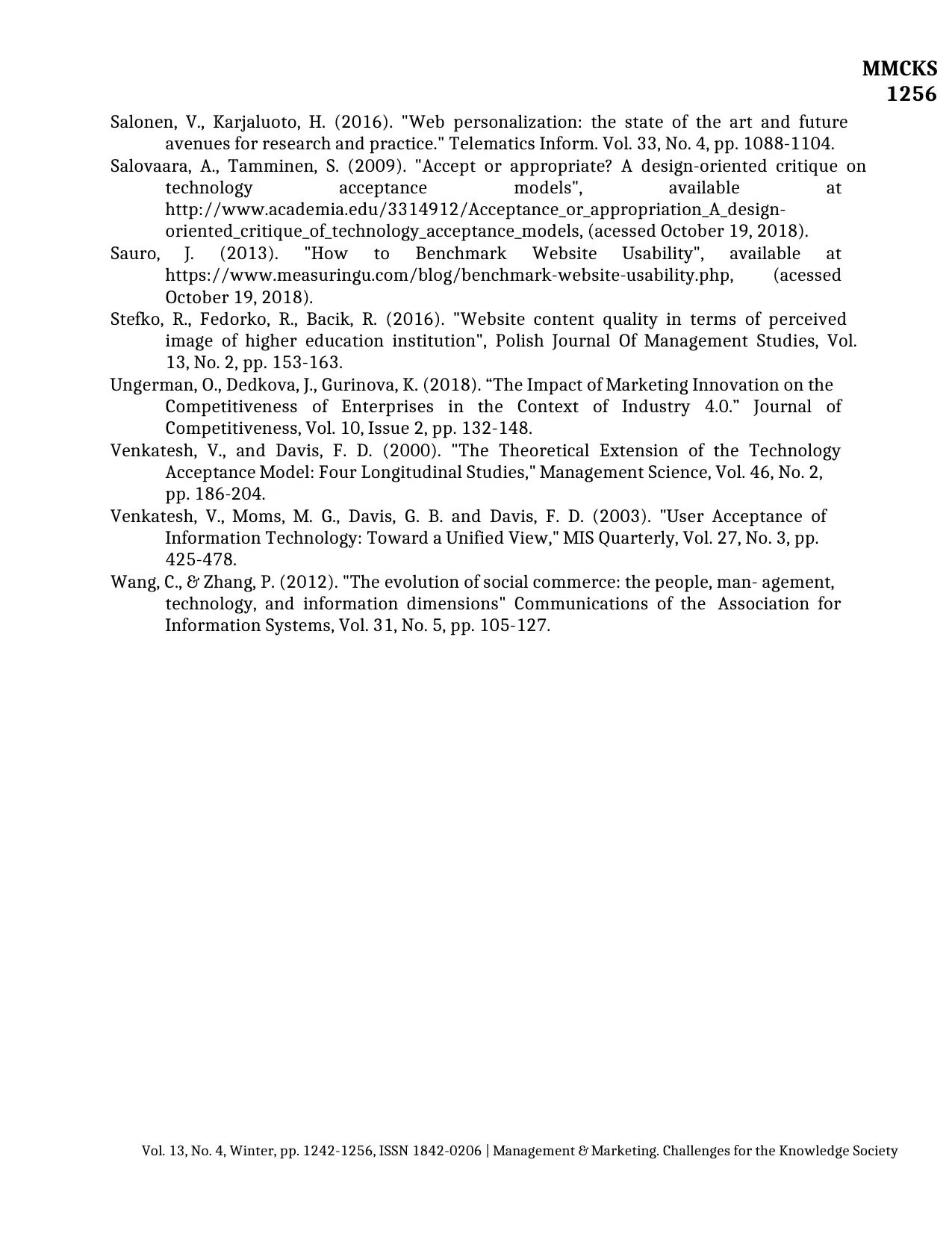
MMCKS
1256
Vol. 13, No. 4, Winter, pp. 1242-1256, ISSN 1842-0206 | Management & Marketing. Challenges for the Knowledge Society
Salonen, V., Karjaluoto, H. (2016). "Web personalization: the state of the art and future
avenues for research and practice." Telematics Inform. Vol. 33, No. 4, pp. 1088-1104.
Salovaara, A., Tamminen, S. (2009). "Accept or appropriate? A design-oriented critique on
technology acceptance models", available at
http://www.academia.edu/3314912/Acceptance_or_appropriation_A_design-
oriented_critique_of_technology_acceptance_models, (acessed October 19, 2018).
Sauro, J. (2013). "How to Benchmark Website Usability", available at
https://www.measuringu.com/blog/benchmark-website-usability.php, (acessed
October 19, 2018).
Stefko, R., Fedorko, R., Bacik, R. (2016). "Website content quality in terms of perceived
image of higher education institution", Polish Journal Of Management Studies, Vol.
13, No. 2, pp. 153-163.
Ungerman, O., Dedkova, J., Gurinova, K. (2018). “The Impact of Marketing Innovation on the
Competitiveness of Enterprises in the Context of Industry 4.0.” Journal of
Competitiveness, Vol. 10, Issue 2, pp. 132-148.
Venkatesh, V., and Davis, F. D. (2000). "The Theoretical Extension of the Technology
Acceptance Model: Four Longitudinal Studies," Management Science, Vol. 46, No. 2,
pp. 186-204.
Venkatesh, V., Moms, M. G., Davis, G. B. and Davis, F. D. (2003). "User Acceptance of
Information Technology: Toward a Unified View," MIS Quarterly, Vol. 27, No. 3, pp.
425-478.
Wang, C., & Zhang, P. (2012). "The evolution of social commerce: the people, man- agement,
technology, and information dimensions" Communications of the Association for
Information Systems, Vol. 31, No. 5, pp. 105-127.
1256
Vol. 13, No. 4, Winter, pp. 1242-1256, ISSN 1842-0206 | Management & Marketing. Challenges for the Knowledge Society
Salonen, V., Karjaluoto, H. (2016). "Web personalization: the state of the art and future
avenues for research and practice." Telematics Inform. Vol. 33, No. 4, pp. 1088-1104.
Salovaara, A., Tamminen, S. (2009). "Accept or appropriate? A design-oriented critique on
technology acceptance models", available at
http://www.academia.edu/3314912/Acceptance_or_appropriation_A_design-
oriented_critique_of_technology_acceptance_models, (acessed October 19, 2018).
Sauro, J. (2013). "How to Benchmark Website Usability", available at
https://www.measuringu.com/blog/benchmark-website-usability.php, (acessed
October 19, 2018).
Stefko, R., Fedorko, R., Bacik, R. (2016). "Website content quality in terms of perceived
image of higher education institution", Polish Journal Of Management Studies, Vol.
13, No. 2, pp. 153-163.
Ungerman, O., Dedkova, J., Gurinova, K. (2018). “The Impact of Marketing Innovation on the
Competitiveness of Enterprises in the Context of Industry 4.0.” Journal of
Competitiveness, Vol. 10, Issue 2, pp. 132-148.
Venkatesh, V., and Davis, F. D. (2000). "The Theoretical Extension of the Technology
Acceptance Model: Four Longitudinal Studies," Management Science, Vol. 46, No. 2,
pp. 186-204.
Venkatesh, V., Moms, M. G., Davis, G. B. and Davis, F. D. (2003). "User Acceptance of
Information Technology: Toward a Unified View," MIS Quarterly, Vol. 27, No. 3, pp.
425-478.
Wang, C., & Zhang, P. (2012). "The evolution of social commerce: the people, man- agement,
technology, and information dimensions" Communications of the Association for
Information Systems, Vol. 31, No. 5, pp. 105-127.
1 out of 15
Related Documents
Your All-in-One AI-Powered Toolkit for Academic Success.
+13062052269
info@desklib.com
Available 24*7 on WhatsApp / Email
![[object Object]](/_next/static/media/star-bottom.7253800d.svg)
Unlock your academic potential
© 2024 | Zucol Services PVT LTD | All rights reserved.





